

BENTLEY FLYING SPUR

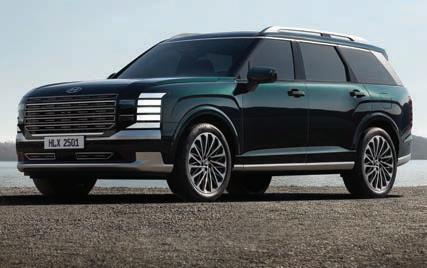

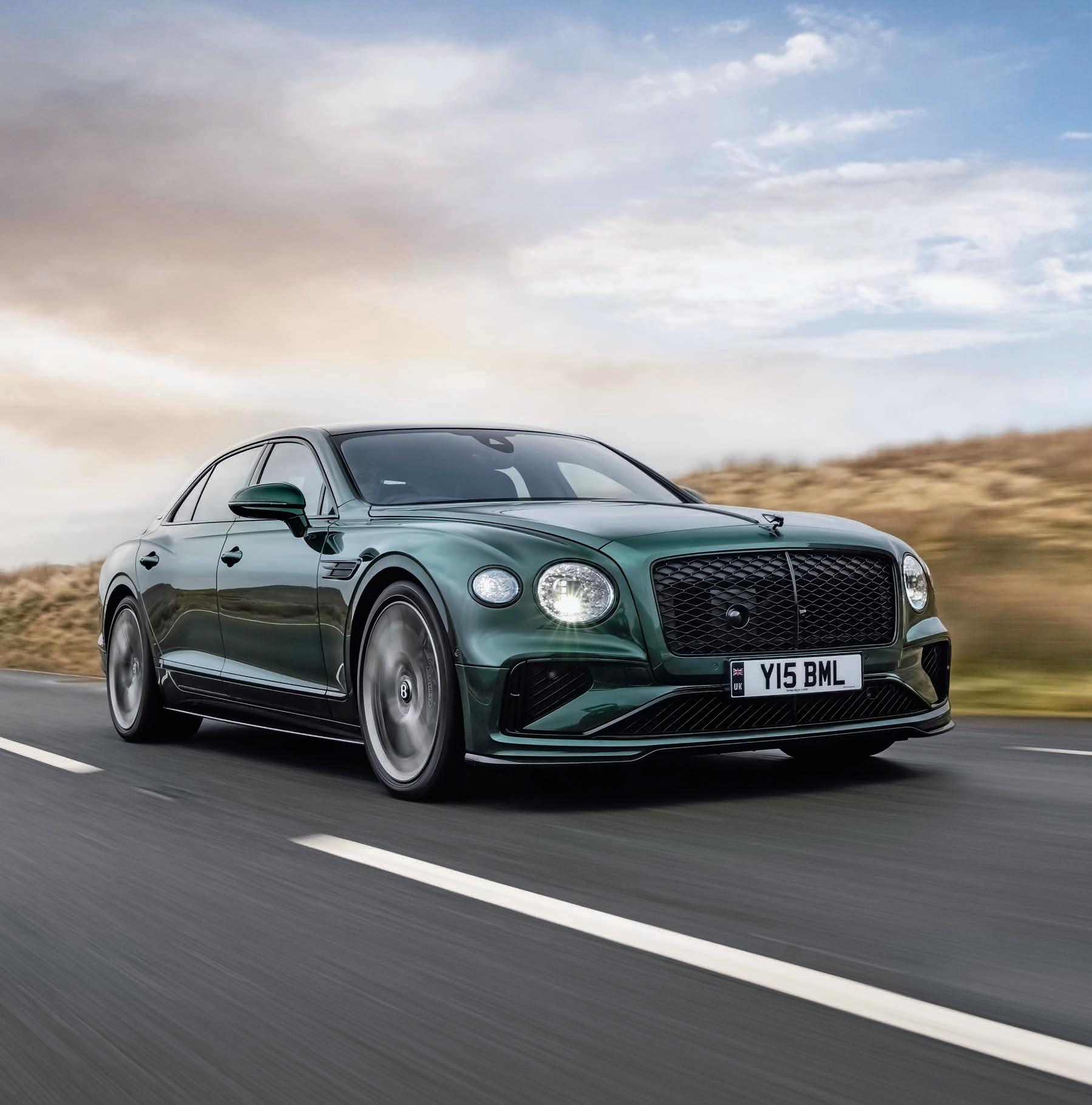

THIS MONTH

Ioniq 5
Honda PH streamlines customer aftersales through Second Insurance Conference with partners in VisMin Evro mobile app launches new EV Charging Station Finder feature 19 Kaiyi Auto PH, Xpress Super App partner to advance electric mobility
Kia PH holds Grand Kia Sonet Pilipinas Club car meet



Editor’s Note


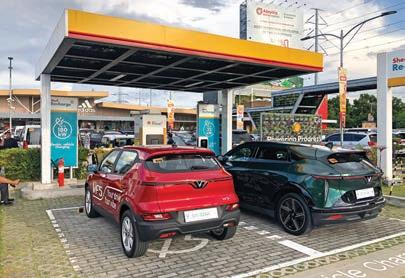
These days, it seems it’s either raining, or the sun’s out—and angry. The past few weeks have been crazy what with one storm after another, perhaps as crazy as the Philippine auto industry will get as we move to the latter part of this year. There’s still a lot to come, trust us. While we wait for all that, we’ve put this August issue together for you.
If you enjoyed our Trip Lang road trip feature last month, you’ll be glad to know this issue has turned into an unofficial road trip edition. We’ve compiled recent media drives we joined with different brands, taking BYD’s Sealion 5 PHEV, Kia’s Turbo Hybrid Sorento, the VinFast VF6, Toyota’s Tamaraw, and Chery’s rEv PHEV to some scenic spots. Quite a motley mix of brands and vehicle types, showing just how our market has something for every taste and preference. Our main feature is the Bentley Flying Spur—a V8 hybrid that puts out more power than its V12 predecessor. That alone might make you want one, but even if your wallet can handle it, you’ll still have to convince your better half to let you add it to the garage.
August is often referred to as the Ghost Month, when things supposedly slow down. But we have a feeling that car companies won’t use that as an excuse to let the competition get ahead. Expect more than a few happenings to keep us busy—and for you, that means more choices!
Let’s keep our fingers crossed that if there are any more storms, they steer away from the Philippines so we stay relatively dry as we transition from Q3 to Q4. Floods are such a burden on our countrymen, and it saddens us here at Autocar Philippines to see so many vehicles lost to water damage.
Stay safe, and may you—and your vehicles—always find higher ground!


A New Beginning in Lancia’s Rallying Legacy
Lancia returns to the thrill of rallying as it reignites its passion for motorsport.
The Ypsilon Rally4 HF marks a bold step forward, combining amazing performance with the spirit of Lancia’s iconic rally heritage. With the Trofeo Lancia, a new chapter for Lancia’s rally begins, one that celebrates the brand’s legacy of innovation, precision, and a deep connection to the road.
It was back in the Seventies and late Nineties that Lancia carved its name in rally history, dominating the global stage with passion, innovation and excellence. From the fearless Lancia Fulvia Coupe HF to the untamed power of the Delta S4, every victory was more than just a win. It was a triumph of Italian ingenuity and spirit.
With 11 Manufacturers titles, 5 Drivers, 74 victories and 193 podiums, Lancia’s rallying legacy remains unrivaled. Every milestone, every trophy tells a story of grit, speed and the relentless pursuit of greatness.
The Trofeo Lancia’s debut in the 2025 Italian Rally Championship covers five events across Italy including the picturesque roads of Sicily. Starting from Targa Florio last May and ends with the last event in San Remo in October
Dedicated to the new Ypsilon Rally4 HF, the series offers aspiring drivers the chance to compete for an almost $500,000 prize pool with the ultimate consolation for a seat with the Lancia Corse HF Team in the 2026 European Rally Championship.
The Ypsilon Rally 4 HF is built for the thrill of competition, equipped with a 1.2 Turbo three-cylinder engine delivering an impressive 212 HP. Its 5-speed sequential transmission
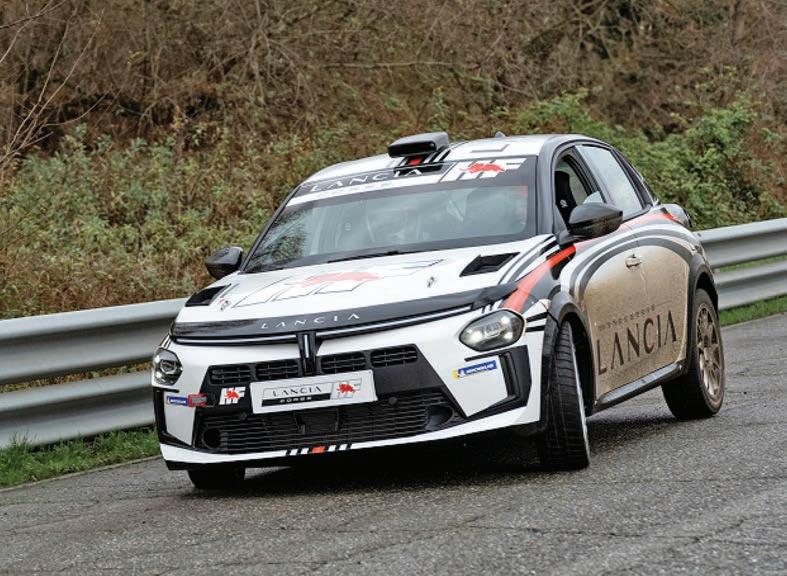
and self-locking differential ensure precision and control, while the frontwheel drive configuration provides agility and outstanding performance. The Ypsilon Rally 4 HF represents pure passion and is the perfect entry point for young drivers.
The historic bond between Sparco and Lancia, forged in the rally victories of the ‘80s and ‘90s, is back stronger

than ever.
Sparco equips the new Ypsilon Rally4 HF with top-tier components and provides all Trofeo Lancia 2025 drivers with custom fireproof racing gear in Lancia Corse HF colors. The partnership also extends to teamwear, worn by Lancia Corse HF drivers, technicians, and staff.
Michelin is the official tire supplier for Trofeo Lancia; Michelin and Lancia strengthen their partnership, getting ready for this race experience.
This collaboration underscores their shared commitment to performance and innovation, ensuring top-tier driving excellence.


Steve Cropley
SATURDAY, SUNDAY
What a week! It began with a lingering visit to one of the few motor shows I’d never attended: Race Retro in the old Royal Showground at Stoneleigh Park, south of Coventry. You can feast your eyes on all kinds of racing cars from newish to very old and watch some healthy ones (rally cars) being driven in anger on tracks just outside the main pavilions.
It’s a friendly, slightly homespun event, busy but not rammed, where you can feel everyone’s anticipation for the impending race season.
It’s amazing what’s offered: even if you’re no use with a spanner (like me), you can still admire the beautifully engineered hot bits offered everywhere.
I went with one of my sons, whose current fixation is the ‘dog-bone’ Ford Escort Mk1. We must have looked at half a dozen prime RS1600s, RS2000s and Mexicos, many for sale, but managed to restrict ourselves to a prime-looking 1:43-scale Twin Cam. Also prominent was a stately 07-plate Bentley Arnage that eventually sold for £23,000 to someone who, as well as loving luxury, is probably a bit of a gambler.
MONDAY
I took my new, red Jeep Wrangler Sahara (first report coming soon) on its first decent trip – to Crewe from London in the rain – and was surprised by its ability to roll pleasantly along in its ultra-tall seventh gear, delivering almost 30mpg. I had imagined motorways might be a bit of a trial, but the Sahara is much more house-trained than the Rubicons I’ve known. I found myself thinking this could be a decent daily driver, but we will see.
TUESDAY
A delightful day in the bosom of Bentley, attending one of those driving/talking days they do better than anyone else in the world. I grabbed a fascinating half hour with CEO Frank-Steffen Walliser (expect a podcast) but otherwise devoted myself to driving the new V8hybrid Flying Spur limo. Last year I spent several months in the V6 Spur, which was so excellent that I didn’t entirely trust myself to perceive the improvements brought to this latest version by more V8 poke, even more versatile air suspension and a rear-steer system. But the benefits were soon obvious: the new Spur is flatter and quieter, is more discreetly powerful and, although it’s

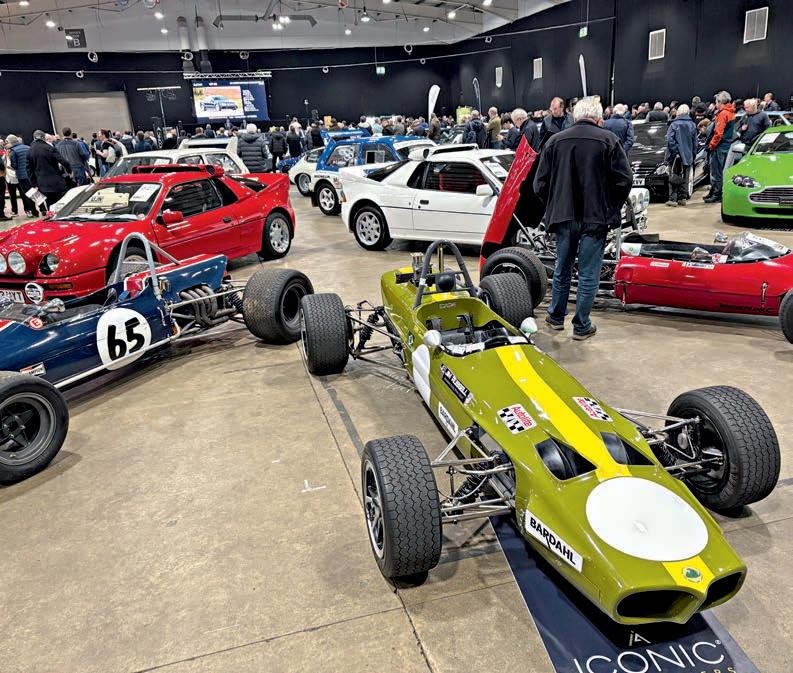
“I’m extra lucky: our Alpine A110 needs an MOT today ”
5.3 metres long, manoeuvres like a Volkswagen Passat. It might now be the best Bentley of all. Driving the Wrangler back home after being so thoroughly steeped in non-Jeep luxury was still pleasant – a decent test of its all-round enjoyability, I reckon.
WEDNESDAY
Lots of ‘new opportunity’ stuff in the press from new Peugeot boss Alain Favey reminds me to record my great admiration for his remarkable predecessor, Linda Jackson, now retired, who brought much good change to the famous French company, and to Citroën before that.
Jackson has surely set an all-time record by being the only British woman ever to run two French car companies. More to the point, she did both jobs brilliantly, with a unique mix of style and quiet authority. Citroën’s return to delivering automotive comfort, one of its greatest traditions, happened on her watch, and it continues to make double-chevron cars special.
THURSDAY
As I write, I think we’re experiencing That Day. It’s the one that comes towards the end of every winter, when the days have lengthened a bit, there’s sun on your back when you walk outside and the keys to the garage doors seem shinier

than usual. The roads are dry, and I’m extra lucky: our Alpine A110 needs an MOT today and our local tester is 10 enjoyable miles away. What’s more, snow isn’t forecast tomorrow…
AND ANOTHER THING
I’ve been devouring Motorsport UK’s latest StreetCar newsletter (all about low-end car competition), because it has a story by John Chambers, a bloke I’ve actually raced, about running a Tesla Model 3 Performance in hillclimbs and sprints. Well schooled in other disciplines, John’s awesome in EVs, and the fact that he now likes them best answers pertinent questions about whether they’re the right mix of challenge and fun.
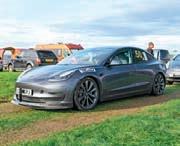
Jackson led Peugeot and Citroën in a stellar 48year automotive career
…including this ’60s stunner, Cropley’s latest set of wheels
There was an abundance of supreme metal at Retro Rides to browse and buy…

EDITORIAL TEAM
IRA V. PANGANIBAN Editor-in-Chief
EDGAR QUESADA Associate Editor
NEIL PAGULAYAN Executive Editor
BINKY SIDDAYAO Technical Editor
OLSON CAMACHO Off Road Editor
MATT PRIOR | KRIS LIM | BINKY SIDDAYAO Columnists
JOHN REY SAN DIEGO Staff Writer
WILLIAM HERRERA | LUIS GERONA | RANDY PEREGRINO Contributors
ANJO PEREZ Senior Photographer
BONG BOADO | KEITH MARK DADOR | LOUIE CAMACHO
MARK QUESADA | ALAN RANCH SEVILLA | RANDOLPH DE LEON
ARNOLD RIODEQUE | BOBS JEROME | MEMERT MONTELOYOLA
Photographers
RAYMUND RAVANERA Graphic Designer
EDITORIAL TEAM
ANJO PEREZ Editor-in-Chief
RICA SISON, JOSEPH BAUTISTA, LARA CAMACHO Contributors
WILLIAM HERRERA, NEIL PAGULAYAN
MARK QUESADA Photographer
JOHN REY SAN DIEGO Staff Writer
RAYMUND RAVANERA Graphic Designer
Contact us at info@wheelsph.com
Wheels Magazine is published monthly, a registered trademark of Asian Media Ventures, Inc. in cooperation with Gulf News. Copyright 2015.
IN MEMORIAM
Alan Ranch Sevilla • Earl Manalansan • Dino Ray Directo III • Edward Dangan II
Editor Mark Tisshaw
Editor-in-Chief Steve Cropley
Magazine Editor Rachel Burgess
Acting Managing Editor James Attwood
Digital Editor Murray Scullion
Editor-at-Large Matt Prior
Deputy Editor Felix Page
Road Test Editor Matt Saunders
Deputy Road Test Editor Richard Lane
Road Tester Illya Verpraet
News Editor Will Rimell
Autocar magazine and the Autocar logo are trademarks of Haymarket Media Group Limited, United Kingdom and used under license by Autobrands Media Ventures, Inc. Content reproduced from Autocar magazine © Haymarket Media Group Limited 2011 all rights reserved.
The views and opinions expressed within Autocar PH magazine are not necessarily those of Haymarket Media Group Limited or those of its contributors.
Autocar magazine is published in China, Greece, India, Indonesia, Malaysia, Philippines, Poland, Singapore, Thailand, and United Kingdom.
www.haymarket.com

Published by ASIAN MEDIA VENTURES, INC.

No.44 Gng. Aurora Quezon Ave BF Manresa, BF Homes, Parañaque City Telephone No. (02) 8-9259179
CORPORATE TEAM
Chairman of the Board GEORGE APACIBLE
President IRA V. PANGANIBAN Vice President RONALDO TRINIDAD
Secretary OLSON CAMACHO
Treasurer EDGAR QUESADA
Board Director ANJO PEREZ
Director for Sales and Marketing CAROL “DANG” B. DORIA Administrative Head KAITE S. BELGICA
All rights reserved. Printed in the Philippines. Reproduction in whole or in part without permission of Asian Media Ventures, Inc. is prohibited. For inquiries on advertising, distribution or subscription, please call (02) 8925-9179 or email info@wheelsph.com
The views and opinions expressed within Autocar Magazine are not necessarily those of Asian Media Ventures, Inc. or those of its contributors. While every care has been taken in the preparation of this magazine, the publishers cannot be held responsible for the accuracy of the information herein, or any consequences arising from it. In case of all product reviews, judgements have been made in the context of the product based on Philippines prices at the time of review, which are subject to fluctuation and only applicable to the Philippines market.

Are Toyota Hybrid Electric Vehicles reliable for real-world use?
Toyota conducts Goyokiki Activity
The thought of switching from a traditional Internal Combustion Engine (ICE) to a Hybrid Electric Vehicle (HEV) may be daunting for Filipino car buyers who have spent almost the entirety of their lives driving or being driven in traditional ICE vehicles. It’s understandable that they would have concerns about hybrid technology and how it works. Then there is battery life and maintenance.
Toyota makes switching from an ICE vehicle to a Toyota HEV easy, as it drives and feels just like a regular car, with little to no noticeable difference for most users in terms of driveability. The key difference lies in fuel efficiency. Thanks to Toyota’s hybrid technology, HEVs deliver significantly better fuel economy, making them a smart and practical choice for everyday driving.
With a 30-year track record in Hybrid development, Toyota’s systems are tested, reliable, and built to last, even under extreme usage. Proving there’s no need to worry.
Prius for Tacloban PNP
In 2017, 49 Toyota Prius units were provided to PNP Tacloban by the Government of Japan. These vehicles
have now been in use for 8 years, primarily as patrol cars and as expected, these would be operational 24/7.
On June 18, delegates from Toyota Motor Philippines (TMP) went back to the Police Regional Office 8 in Leyte, Tacloban for a special Goyokiki activity, a Japanese term which refers to the practice of going and talking with customers to understand their needs, to see how the Prius, equipped with Toyota’s 4th generation hybrid technology, had stood up to daily use by Tacloban’s police force in 8 years.


Present were Mr. Marvin Gardiner, TMP Vice President for CSO Service Planning and Administration Department, together with Mr. Dave Fenis, Service Manager of Toyota Tacloban, and PNP Tacloban officers.
Upon inspection, 26 of the 49 Prius units available had been driven an average of 193,000 kilometers, with the highest mileage recorded at over 300,000 kilometers driven. It was noted that these were used extensively in tough, real-world conditions, some driven up to 300 kilometers daily.
User Feedback
The local Police officers who used the vehicles daily had generally positive observations, with emphasis on the instant acceleration Power Mode gave them, with no delay in throttle response compared to their ICE vehicles. The Prius also proved reliable and comfortable for daily use. The Tacloban Police were satisfied with the low cost of ownership, and the easy scheduling of periodic maintenance service with Toyota Tacloban was a big benefit.
Findings
On top of the feedback from personnel who used the vehicles daily, they also conducted a technical evaluation of the vehicles. They found the engine, drivetrains


and hybrid batteries were still in good condition. The hybrid batteries still showed low internal resistance, a key indicator of good battery health and performance. Internal resistance measures how easily a battery can deliver power; lower values mean better performance and efficiency. The 26 Prius units showed 0.020 Ohms of average internal resistance, evidence that Toyota’s hybrid batteries were still performing at optimal levels even after eight years of continuous use.
As expected, the under chassis of their Prius police vehicles had minor issues due to wear from being driven on rough roads, and thus, not a vehicle defect.
PLTCOL Roderick P. Condag, Acting Chief, RLRDD of PNP, Police Regional Office 8 expressed deep appreciation: “We sincerely thank TMP for going the extra mile to visit Tacloban and support our personnel. Toyota has never neglected us and continues to provide dependable aftersales service.”
Toyota HEV – QDR Proven.
It goes to show that Toyota is a trusted brand with its legendary Quality, Durability, and Reliability (QDR), even in demanding environment. Toyota HEVs remain efficient, durable, and cost-effective.

FRESH OUT THE BOX
A downpour of new vehicles
With July mostly wet from all the typhoons that inundated us, the local automotive industry joined in the downpour with the new model additions that happened during the month. Many among the bunch are electrified offerings with some featuring advanced, smart technology for road safety and driving convenience.

BMW M5
SMC Asia Car Distributors Corp., the official local distributor of BMW, officially launched the seventh generation BMW M5 nameplate in the Philippines. Available in both sedan and wagon configurations, both the M5 and the M5 Touring are fitted with a high-revving twin-turbo 4.4-liter V8 engine with an integrated electric motor hooked up to an 8-speed transmission. Combined, the system produces 727 hp and 1,000 Nm of torque, which can achieve a maximum speed of 305 km/h if the M Driver’s Package is equipped.
A high-voltage 18.6 kWh battery pack is also mounted just beneath the chassis for all-electric driving. In EV mode, the all-new M5 can be driven at speeds of up to 140 km/h. The M5 and the M5 Touring share this EV system, but the former tops out at a range of 69 km, while the latter can reach 67 km.
Dongfeng E70 Pro
Dongfeng Motors Philippines’ latest offering is a fullelectric compact sedan that is perfect for fleet use. The Dongfeng E70 Pro comes with a spacious cabin and comfortable leather seats as well as a large trunk space of 502 liters.
It boasts a 420-kilometer range, powered by a 52.99 kWh ternary lithium-ion battery that drives a permanent magnet synchronous motor, putting out 120 hp and 230 Nm of torque. The E70 Pro has acceleration performance of reaching to 60 kph in 4.3 seconds and 0 to 100 kph in 9.5 seconds. Pretty impressive for a fleet vehicle. For convenience, it can fast charge from 30-80% in 36 minutes. Slow charging can achieve a full battery in 8.5 hours.

WORDS BY JOHN REY SAN DIEGO

Geely EX5
The new Geely EX5 is the brand’s first full-electric SUV in the country. The EX5 runs on Geely’s short blade battery and an 11-in-1 intelligent electric drive system. It charges from 30% to 80% in just 20 minutes and achieves excellent energy efficiency via IGBT optimization.
Signature features include flush electric door handles, a panoramic sunroof, and antibacterial interior materials. Its clean silhouette signals a more modern, wellnessminded SUV experience. Inside, the EX5 is powered by the Flyme Auto cockpit, featuring a 15.4-inch touchscreen, a 13.8-inch HUD, voice control, and L2 ADAS with 360-degree panoramic parking and transparent chassis view.
Geely Okavango Elite
Geely’s 7-seater SUV is back, and it packs some updates. The Okavango Elite is a hybrid SUV that features seven fully independent seats for comfort as well as flexibility. It also features a maximum cargo space of 2,050 liters, which can be used for various hauling needs.
The Geely Okavango Elite’s key upgrades include refreshed exterior styling, a more refined interior, a wide-angle 360° camera system, and a highstrength steel framework for better protection.
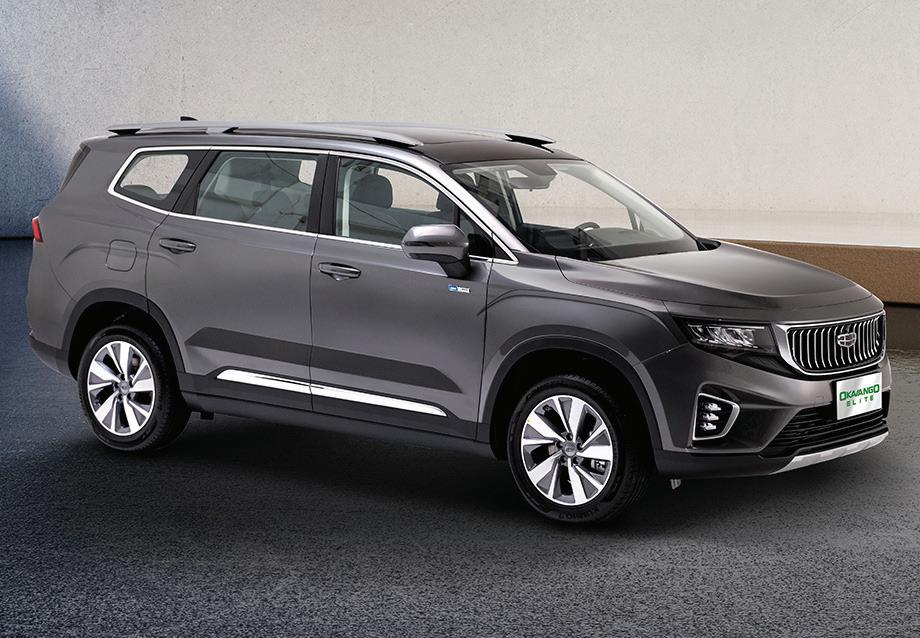

Hyundai Motor Philippines introduced the updated Ioniq 5 with styling improvements among many others. The new Hyundai Ioniq 5 now features a redesigned front bumper and new alloy wheels, plus a more modern and aerodynamic profile. Hyundai also added a new rear wiper, while digital side mirrors are added as a major update. It also comes with expanded Hyundai SmartSense capabilities, assuring not only convenience but also safer drives.
Hyundai Ioniq 9 Hyundai Ioniq5

Further expanding its full electric lineup, HMPH officially launched the Hyundai Ioniq 9. The full-sized 6-seater electric SUV comes standard with flush-type door handles and digital side mirrors. It also has a panoramic sunroof and rolls on a set of 21-inch alloy wheels.
The Ioniq 9 is powered by a 610-volt, 110.3 kWh Lithium-ion battery, which runs a Permanent Magnet Synchronous motor and produces up to 308 horsepower and 605 Nm of torque, driving all four wheels. The family SUV has a range of 600 kilometers on a full charge and has Multi-Terrain Control and V2L (Vehicle-to-Load) functionality.

Hyundai Palisade
The Palisade nameplate is back, and it is now electrified. The all-new Hyundai Palisade now packs a hybrid powerplant. Under the hood of the premium 7-seater hybrid SUV is a turbocharged 2.5-liter hybrid gasoline engine with an electric motor, putting out a combined output of 334 horsepower with 422 Nm of torque, mated to a 6-speed automatic transmission that drives all four wheels.
Maserati Folgore model range

Modena Motorsports, Inc. officially brings in Maserati’s first full electric vehicle offerings in the country, the GranCabrio Folgore and the Grecale Folgore. The GranCabrio is the world’s first all-electric luxury convertible, powered by an 800V architecture and triple-motor layout producing up to 761 hp and 1,350 Nm of torque. It tops up at 290 km/h and boasts an impressive 0-100 km/h acceleration in just 2.8 seconds. The fully retractable soft-top opens in 14 seconds even while in motion.
Meanwhile, the Grecale Folgore is the brand’s first fully electric SUV. It packs 410 kW of power and 820 Nm of torque from its dual electric motors, with its power coming from a 105 kWh battery. The full electric SUV has the brand’s DNA of luxury, dynamism, and technology. It also offers fast charging capabilities, a highly connected digital driving interface, as well as utilizing innovative materials like ECONYL or recycled nylon for its interior panels.

Mercedes-Benz Philippines introduces the V 220d Elegance, a premium iteration of the V-Class designed to elevate both professional and personal mobility. Targeting discerning clients, the V220d Elegance is an upgraded variant that packs style and substance.
The first update is the distinct 18-inch alloy wheels exclusive to the Elegance variant. Other exterior updates, such as the front grill, chrome hood insets, and redesigned bumpers, are exclusive to the V-Class Elegance variant.

MG ZS Mercedes-Benz V-Class
MG Motor Philippines launched the all-new generation MG ZS. Built from the ground up, the new ZS brings a stronger, sleeker, and more refined presence, infused with the latest in global design and engineering. The all-new MG ZS embodies the brand’s new global design identity. It features the “Connected Hunter Eyes” LED headlights, which flow to its sculpted sides, completing the new bold and aggressive front fascia. It is also now 107mm longer and 9mm wider than its predecessor.
Now offered with a hybrid electrified engine, the all-new MG ZS Hybrid+ is powered by a 1.5-liter four-cylinder engine mated to a 1.83 kWh battery and 100 kW electric motor, a combination that is rated to produce 197 PS of power. On the other hand, the MG ZS Sport is powered by a 1.5-liter turbocharged engine that packs 170 PS and 275 Nm of torque. A naturally aspirated 1.5-liter four-cylinder engine powers the mid and base model variants.

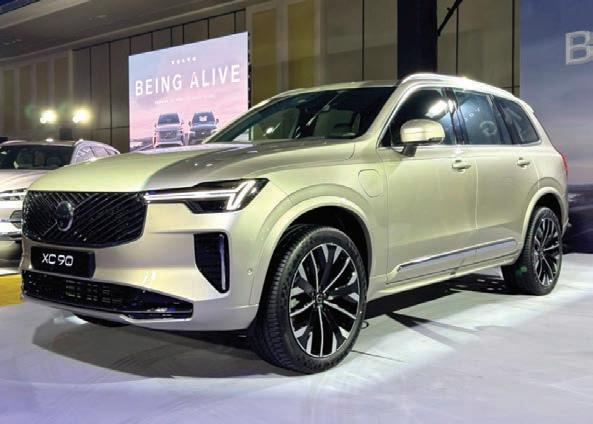

Volvo XC90Volvo XC60
The Swedish marque’s flagship SUV is now here in the Philippines. The Volvo XC90 combines electric efficiency with the reliability of a 2.0L 4-cylinder petrol engine, offering up to 77 kilometers of pure electric range. Its luxurious three-row cabin is appointed with Nappa leather, real wood accents, and an intuitive safety-focused design. Inside and out, the XC90 embodies thoughtful leadership, making it the ultimate SUV for professionals and families who lead with responsibility.
Zeekr 7X
Another electrified Volvo made its way to the Philippine shores, the Volvo XC60. The XC60 packs up to 80 kilometers of all-electric range and an e-AWD powertrain that seamlessly blends an internal combustion engine (ICE) with an electric rear motor. Ideal for city dwellers and weekend adventurers alike, the XC60 offers agile, intelligent performance wrapped in sleek Scandinavian styling.
Along with the opening of the first Zeekr showroom in the Philippines is the arrival of the Zeekr 7X. The next generation luxury SUV is a full electric model that features refined styling, intelligent technology, and versatile functionality.

The 7X boasts fast charging speeds of up to 480 kW. It can be charged from 10 to 80% capacity in just 13 minutes. The full electric luxury SUV is available in two variants: Long Range and Performance.

TOYOTA PH ENDORSES END-OFLIFE DISMANTLING FACILITY FOR INSURED VEHICLES IN CAVITE NEWS
Toyota Motor Philippines Corporation (TMP) officially endorses Standard Insurance Co., Inc. as the second model End-of-Life Vehicle (ELV) dismantling facility in the Philippines, included in the ‘Toyota Global 100 Dismantlers Project.’
Standard Insurance’s ELV dismantling operations primarily handle vehicles insured under its portfolio, with an average of 850 vehicles dismantled annually. Located in the company’s technical and training center in Naic, Cavite, the facility spans approximately 8,840 square meters and has a dismantling capacity of up to six (6) units per day.
Backed by an investment of PHP
17.8 million, this initiative represents a major private sector involvement in appropriate vehicle life cycle management and circular economy.
End-of-Life Vehicle (ELV) dismantling facilities serve as a vital foundation for building a circular economy in the automotive industry. These facilities ensure that inoperable vehicles are processed responsibly, minimizing environmental impact by safely managing hazardous materials and maximizing resource recovery for reintroduction into the manufacturing cycle.
With two established dismantling facilities now operating in the country, the private sector beefs up the local
capacity for responsible ELV management. This expansion not only supports local sustainability efforts, but also addresses the climate-related risks posed by ELVs globally.
Standard Insurance bolsters the Toyota Global 100 Dismantlers Project, being the fifth on its list in the Southeast Asian region.
“We are very grateful to Standard Insurance
for its voluntary resolve, making Toyota customers also feel assured with a proper place for ELVs to go,” said TMP president Masando Hashimoto.
“Our collective efforts are a clear testament to our longterm commitment to carbon neutrality and ‘Establishing a Recycling-based Society and Systems’ under the global
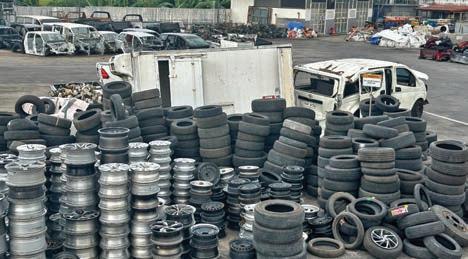
Toyota Environmental Challenge 2050,” Hashimoto added.
The Toyota Global 100 Dismantlers Project is a worldwide initiative that seeks to establish proper ELV dismantling operations in different strategic locations around the world. Through this network, Toyota aims to address key environmental challenges such as pollution and resource depletion by promoting responsible disposal and recycling practices.
Standard Insurance, a partner in TMP’s ‘Toyota Insure’ program since 2021, follows En Tsumugi ELV Dismantler Corporation, the first ELV dismantling facility endorsed by Toyota in September 2024 in Mexico, Pampanga.
ISUZU PH STRENGTHENS
ENVIRONMENTAL AND EDUCATIONAL INITIATIVES
IN ALAMINOS
As part of its continuing efforts to promote environmental responsibility and community development, Isuzu Philippines Corporation (IPC) has donated PHP300,000 to support the mangrove rehabilitation program of the City Government of Alaminos, in coordination with its Community Environment and Natural Resources Office (CENRO).
The donation will support ongoing mangrove planting activities aimed at enhancing coastal protection, increasing biodiversity, and mitigating climate change through carbon sequestration. This contribution is part of IPC’s long-standing collaboration with Alaminos, which began in 2005 when the company adopted a local coastal area for conservation.
“Beyond our commitment to providing reliable transport solutions, we are equally dedicated to restoring and preserving the ecosystems that support our communities,” said IPC Executive Vice President Yasuhiko Oyama. “This initiative reflects our broader mission to contribute to inclusive and sustainable national development.”
In addition to its environmental support, IPC extended assistance to Longos Elementary School,

located in a remote coastal barangay of Alaminos. The company distributed backpacks, notebooks, and other school supplies to 140 students and donated two printers with ink refills to help improve classroom and administrative functions. The initiative aims to support access to basic education and reduce economic pressure on families in the area.
Mayor Arth Bryan Celeste of Alaminos expressed appreciation for IPC’s continued involvement in the city’s development. “Isuzu Philippines has remained a dedicated partner since 2005. Their latest support to our environmental and educational programs
proves how meaningful collaboration with the private sector can lead to lasting impact.”
The initiatives align with IPC’s corporate values and the United
Nations Sustainable Development Goals, particularly those promoting quality education, climate action, and marine ecosystem preservation. With these efforts, Isuzu Philippines reaffirms its role as a responsible corporate citizen working towards a more resilient and inclusive future.

HONDA PH STREAMLINES CUSTOMER
AFTERSALES THROUGH SECOND INSURANCE CONFERENCE WITH PARTNERS IN VISMIN
On June 4, 2025, Honda Cars Philippines, Inc. (HCPI) conducted its second Honda Cars Insurance Conference at Seda Ayala Center, Cebu. This was similar to the first one held in Muntinlupa last March 26, serving as a way for HCPI to bridge the gap between its insurance partners and dealers. It aimed to strengthen the coordination between the stakeholders and improve collaboration in the Body & Paint Repair business by showcasing demonstrations from HCPI’s Body and Paint Estimation Tool, which has been integrated into
the E-Checksheet Mobile Service Tablet used by service advisors at the dealerships.
In attendance were the following insurance partners:
• Malayan
• Oona Insular
• Philippine British
Alpha Insurance
• BPI MS Insurance
Sterling Insurance
Cocogen
Commonwealth • FPG
Pacific Union
Pioneer
Prudential
• Standard
• Mercantile
• Western Guaranty
• Paramount

These insurance conferences foster enhanced communication and transparency between
and insurance partners, reducing the turnaround time needed for LOA approval once a customer brings their unit to the dealers for service.
Find your nearest Honda Cars Dealership at https://www.hondaphil. com/dealer-finder or book a service at www. hondaphil.com.
EVRO MOBILE APP LAUNCHES NEW EV CHARGING STATION FINDER FEATURE
Evro, the country’s leading e-mobility service provider, has launched a new feature in its mobile app that aims to make electric vehicle (EV) charging more accessible and convenient. The newly introduced Station Finder integrates a comprehensive map view of over 240 Department of Energy (DOE)-registered public charging stations across the Philippines. Designed to support trip planning and reduce range anxiety, the feature allows users to locate both partner and nonpartner EV charging stations in real time. Users can view station availability, access smart filters to narrow down their search by compatibility, charger
type, or availability, and enjoy seamless in-app services at Evro partner stations.
Evro also introduced color-coded map pins for easy station identification: Green: Available Evro Partner Station Red: Busy Evro Partner Station Gray: Incompatible, Unavailable, or Nonpartner Stations
Additional app updates include quick access to help resources, FAQs, and deeper customization through advanced filtering options.
This development is part of Evro’s broader goal to build an inclusive and customer-focused EV ecosystem in the Philippines. Through close collaboration with local charge point operators,
Evro continues to expand its coverage and services to meet the growing demand for EV mobility.
The Evro app is
available on the Apple App Store and Google Play Store. For more information, visit www. evro.ph.

Honda Cars dealers
KAIYI AUTO PH, XPRESS SUPER APP
PARTNER TO ADVANCE ELECTRIC MOBILITY

Kaiyi Auto Philippines has announced a strategic collaboration with Xpress Super App, the country’s leading mobility and logistics platform, in a joint effort to drive the adoption of sustainable transportation across the Philippines. This initiative will integrate Kaiyi’s latest electric vehicle (EV) technologies into Xpress Super App’s expanding service network.
This partnership reflects a shared commitment to creating cleaner, more efficient, and technology-driven mobility solutions that align with the evolving demands of modern transportation. Central to the collaboration is the goal of reducing carbon emissions and promoting environmentally conscious travel options, both in urban centers and regional areas.
“This partnership with Xpress Super App is a major step in Kaiyi Auto Philippines’ goal of redefining mobility in the country,” said Anton Ibarle, Managing Director of Kaiyi Auto Philippines. “Innovation and sustainability are central to our mission, and this collaboration allows us to deliver smarter, cleaner transport solutions to more Filipinos.”
Mayka Reyes, Marketing Manager of Kaiyi Auto Philippines, added, “Through this alliance, we demonstrate what the Kaiyi brand represents — purposeful innovation, modern design, and practical technology. We’re proud to work with Xpress Super App to enhance daily mobility experiences.”
Xpress Super App, known for consolidating ride-hailing, logistics, and payment functions into one seamless interface, will incorporate Kaiyi’s electric vehicles — including the newly launched E-Qute 04 — into its fleet. This marks a significant step toward wider EV adoption within the platform’s ecosystem.
Pilot deployments will begin in Metro Manila and South Luzon, allowing local governments and businesses to evaluate the performance of electric vehicles in real-world logistics and transport operations. The initiative supports ongoing national efforts to shift toward greener mobility options.
Kaiyi Auto Philippines will also participate in the TNVS Driver Recruitment and Onboarding event in Balanga, Bataan, on June 20–21, 2025, where attendees can learn more about electric vehicle opportunities and experience the brand’s latest offerings firsthand.
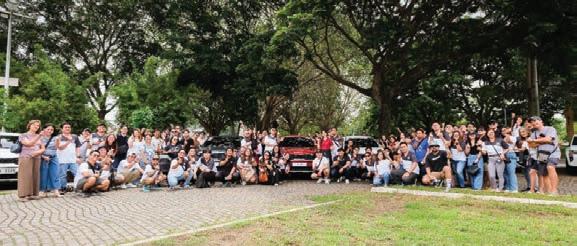

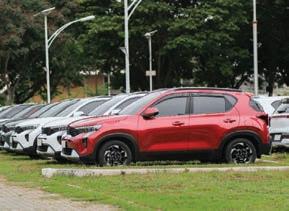
KIA PH HOLDS GRAND KIA SONET PILIPINAS CLUB CAR MEET
Kia Philippines, under AC Motors, celebrated a notable milestone with the first and largest grand meet of the Kia Sonet Pilipinas Club, held at Nuvali in Sta. Rosa, Laguna. The gathering brought together over 60 Kia Sonet vehicles in a convoy from Alabang to Laguna, uniting owners and enthusiasts in a celebration of community, shared experiences, and Kia’s bestselling subcompact SUV.
Marking the first anniversary of the Sonet’s local launch in June 2024, the event reinforced the strong connection between the model and its rapidly growing owner base. The Sonet’s blend of functionality, modern design, and user-friendly features has made it one of the most in-demand models in the entry B-SUV segment.
“Nearly one out of every four entry B-segment SUVs sold in the Philippines today is a Kia Sonet,” said Jay Lopez, Managing Director of Kia Philippines. “This success is driven not only by the vehicle itself but by the dedicated community behind it. Events like this highlight what makes Kia ownership truly unique.”
Designed for practical mobility and real-world use, the Kia Sonet delivers dependable performance, standout fuel efficiency, and versatile features suited for both new drivers and active families. Its design and engineering continue to attract a growing number of Filipino buyers.
Club members like Julienne Bonacua, President of the Kia Sonet Pilipinas Club, spoke about the personal connection owners have with their vehicles. “My Sonet has taken me from Las Piñas to Baguio without hassle. It’s reliable, stylish, and part of my daily life,” she shared.
The Nuvali event also served as a venue for owners to exchange advice, showcase customized units, and foster new friendships, strengthening the club’s foundation as a growing and engaged community.
Club member Darrenz Genel added, “I bought the Sonet for its manual option, tech features, and efficiency. It even played a role in my wedding. This meet allowed me to finally connect with other owners in person.”
The Sonet has earned accolades such as Top Gear Philippines’ “Underrated Car of the Year” and AutoIndustriya’s top recommendation “As Your First Car,” reinforcing its industry recognition alongside strong grassroots support. It is also the first in its segment to offer Advanced Driver Assistance Systems (ADAS), reflecting Kia’s commitment to safe and accessible driving technology.
“This event is a reflection of what Kia stands for—mobility that connects people,” Lopez concluded. “We look forward to supporting the Sonet Pilipinas Club as it grows with its members and new milestones ahead.”
For more details on the Kia Sonet and Kia’s full model lineup, visit www.kia.com/ph or follow Kia Philippines on Facebook, Instagram, and YouTube.
ROAD TRIP

Chery Tiggo rEv C-DM Drive
P500 Challenge W
hat is the P500 challenge? Well, we wanted if we would more or less consume P500 of fuel, driving the recently launched, Chery Tiggo rEv Plug-in Hybrid (PHEV) from our start point, at Chery Commonweaith to Acea Subic Beach Resort in SBMA.
I was partnered with Ian from the Manila Bulletin, and first on our to-do list was to top up with gas at the nearest gas station, and we filled up until the pump stopped the first time. Our battery was charged to about 90%.
I drove the first part and we were caught in the tail end of rush hour traffic, where there were still a lot of vehicles on the road.
We chose EV or electric mode in our time in traffic and set our regenerative braking to its highest setting. Once we got through the toll plaza, entering the expressway, we switched to hybrid mode so the vehicle would decide when it would use electric or combine both ICE and electric, and at the same time, charge up the battery.
Under the hood, the hybrid system is made up of a turbocharged 1.5 Liter gasoline engine, Chery Dual-Mode (CD-M) Dedicated Hybrid Transmission (DHT), and an 18.66 kWh Chery Guardian Battery System. It can do 0-100 in eight seconds, it boasts a 130 kilometer EV range, an extended

Unforgettable Adventures and Epic Scenic Escapes

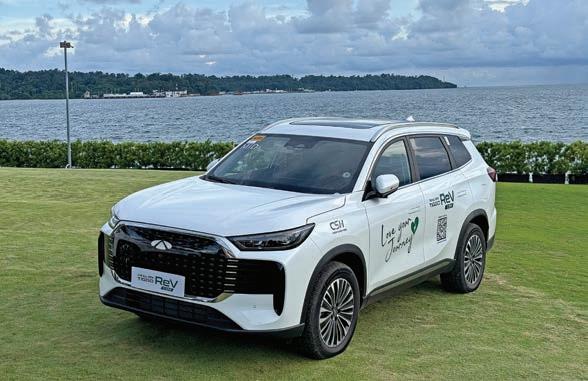
hybrid range of 1,400 kilometers, and fuel consumption of about 23 kilometers per liter. Interesting, yes.
Our first stop was a quick break at one of the gas stations along NLEX so Ian could take over driving duties. We exited to SCTEX, and proceeded to Rancho Bernardo Luxury Villas and Resort in Bataan, roughly 148 kilometers from our start point. We would have lunch there, and take some photos of the Chery Tiggo rEv.
After lunch, my turn behind the wheel again, and we had fun keeping up with the lead car on the twisties, past the Bataan Nuclear Power Plant, and into SBMA’s Morong gate. We headed straight to one of the Petron stations in SBMA and topped up our fuel tank. With 82 kilometers more on our odometer, we totalled up to 230 kilometers driven.
So, how much fuel did we consume? The pump price at that time at Petron for Xtra Unleaded in SBMA was P58.90 per liter. The total amount of gasoline we loaded at SBMA was P53 or .98 of a liter, which was how much we consumed on a 230–kilometer drive, equivalent to 0.004/liter per kilometer. Air conditioning was on at a cool comfortable temperature with the ventilated seats on full, we were blasting tunes off our Spotify playlist on the premium Sony 8 speaker audio system, and we drove as you normally would, on a road trip just to see


our unadulterated fuel consumption results. All in all, we got a pretty good result, but we came in second place. The best fuel consumption topped up with only P47.21, which was just a few squirts less then our consumption. Remember the challenge was set at P500 of gasoline at a top up? Surprisingly, every participant who refueled never consumed more than P300 of gas, so everyone had a pretty economical run.
How did we do it?
Here’s a simple breakdown - a full tank of gas and a full charge on our battery. We switched to EV mode while on ECO for city traffic, which saved us from burning any gas. Once we crossed the first toll plaza in NLEX,
we switched to hybrid mode. Remember, momentum is your friend, and applying light power on rises and coasting on dips.
Lifting off the accelerator saves you fuel, too. And that’s pretty what we did to get our .98 of a liter of fuel consumption for the 230–kilometer drive. Not bad. Way better than the expected 23 kilometers per liter.
The Chery Tiggo rEv proved that even if you made no effort, its hybrid system can take care of being economical for you. Priced at Php1,648,000 and not far from its competitors, which boast similar range capability, it makes it a good choice if you’re in the market for this kind of 7-seater vehicle – EV in the city and Hybrid on the open road.
NEIL PAGULAYAN


BYD Sealion 5 DM-I Media Drive
Real-world efficiency & Marine sustainability
Fresh from its official debut, it was time for us to experience the Sealion 5 DM-i compact crossover in a drive event. The new compact crossover is the latest addition to BYD’s growing electrified lineup, positioned between the Sealion 6 compact SUV and Seal 5 compact sedan DM-i models.
BYD Cars Philippines hosted an experiential drive event for select members of the motoring media. The chosen destination was the Kamana Sanctuary resort in Subic Bay, Zambales.
But unlike the usual itinerary, AC Motors incorporated an introduction to a marine sustainability program. We got to see the “Circular Explorer,” a solar-powered waste collection boat, and met with the people behind the One Earth - One Ocean (OEOO), who operate it.
One Earth - One Ocean
First on the list was to swing by the Manila Bay breakwater area. There, the entire group met Executive Manager Daniel Scheler. The environmental organization, based
in Munich, has developed the concept of “Maritime Waste Collection” to clean up waters worldwide from plastic waste (as well as oil and chemicals).
In early 2022, OEOO launched a new cleaning, recycling, and environmental education project in the Philippines, utilizing a new solar-powered waste collection boat, the Circular Explorer.
Scheler led us to board the uniquely designed vessel to demonstrate the process of waste collection. He explained that the project’s three focal points are maritime waste collection, i.e., the collection and sorting of plastic waste, as well as education and science.
The Circular Explorer is also very flexible due to its shallow draft and can be used on
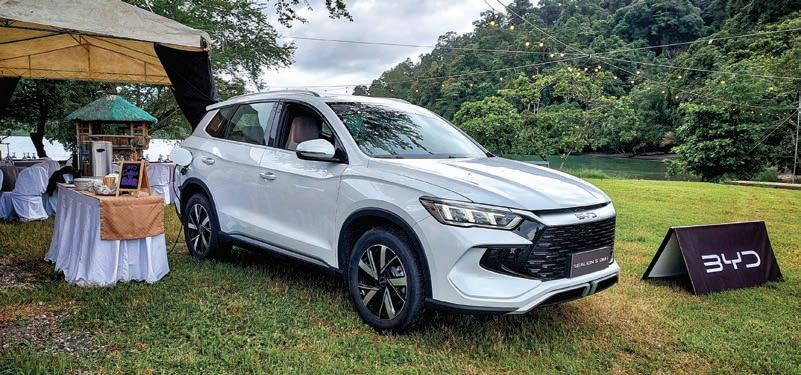
open waters, inland waters, and on the beach to collect waste. More importantly, it is also used as a platform for education, science, and networking events.
It was a great way to start the day with marine sustainability efforts in mind. After all, the Sealion 5 DM-i is part of BYD’s “Ocean Series” lineup. So, it was fitting to align the drive event to the initiative itself.
BYD DM-i DNA
Back to the Sealion 5 DM-i, eleven fresh-fromthe-factory units were commissioned for the drive event. At a glance, the silhouette alone is indicative of its EV sibling, the Atto 3. But dimension-wise, the vehicle measures 4,738 mm in length, 1,860 mm in width, and 1,710 mm in height.
Upfront is a pronounced grille featuring a familiar horizontal bar with the brand emblem united with the sleek-looking full LED lighting. Other design features include heated and power-adjustable mirrors, integrated puddle lamps, stylish roof rails, and 18-inch alloy wheels wrapped in 225/60 series tires.
The tech-forward interior features premium, soft-to-the-touch materials that are combined with intuitive design elements. Highlighted in the center dash is BYD’s signature 10.1-inch rotating touchscreen, featuring wireless Apple CarPlay and Android Auto connectivity. The sporty bucket-type seats are leather-wrapped and well-padded with bolsters.
Some of the standard features include NFC card smart entry, push-start ignition, multiple USB ports, and BYD Cloud Service, which offers over-the-air updates. There is even the BYD App, a mobile phone interface allowing remote control of the vehicle’s security and comfort.
Motivation comes from the brand’s advanced Super DM-i system. This electrified powertrain seamlessly combines electrified propulsion from a Permanent Magnet Synchronous Motor with a high-efficiency 1.5-liter gasoline engine as a generator and range extender.
On paper, the combined output is 194 hp and 300 N-m of torque. Selectable drive modes available are Economy, Normal, and Sport. Electric juice is provided by a 12.96 kWh Lithium Iron Phosphate Blade Battery rated for up to 71 km of pure electric driving range, based on the New European Driving Cycle (NEDC) standard. The total range is over 1,000 kilometers.
Plugged in, the BYD DM-i system supports up to 3.3 kW of AC charging, allowing the Blade Battery to reach a full charge from 15 percent in approximately 4.5 hours. For added versatility, Vehicle-to-Load (V2L) functionality enables the Sealion 5 DM-i to power external devices and appliances, making it ideal for outdoor and on-the-go use, as well as for emergencies when electricity is needed.
The Sealion 5 DM-i may lack ADAS, but it is still equipped with a comprehensive suite of active safety and security features. These
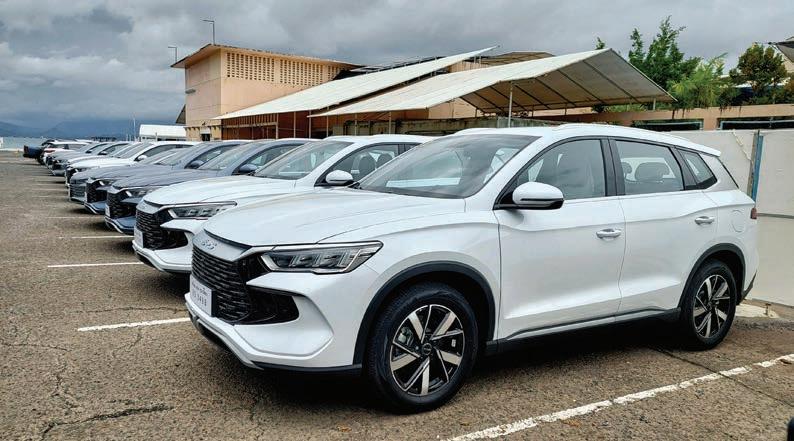

features include Cruise Control, Traction Control System, Electronic Stability Control, Traction Control, Anti Rollover Control System, Vehicle Dynamic Control System, Hill Hold, and Hill Descent Control. Moreover, the vehicle features a rear camera with radar sensors, as well as a Tire Pressure Monitoring System (TPMS). Other standard features include six airbags, ISOFIX child seat anchors, and advanced safety technologies, such as ABS, EBD, and anti-rollover protection.
Eco-run challenge to Subic
Since the entire drive event focused on sustainability, an eco-run challenge driving the Sealion 5 DM-i to Subic Bay was a perfect fit, if not necessary. The objective was simple: to register the least based on the theoretical average “Past 50 km AEC reading” on the instrument cluster display.
From the BYD Manila Bay dealership, the entire convoy flagged off and took the Skyway, Skyway Stage 3, NLEX, and SCTEX route. Together with veteran motoring journalists Ira Panganiban and Anjo Perez, we boarded the Aura White version. Now more accustomed to the DM-i technology, a real-world driving approach while on Eco mode would still deliver good results.
For the initial leg, Panganiban took the helm throughout the Skyway stages up to the Pampanga stretch of NLEX. With more than

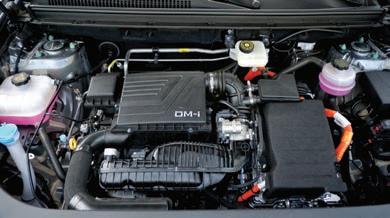
80 percent battery charge, we opted to run on full EV mode.
Despite the morning traffic’s mayhem, inside the vehicle was blissful. The dualzone climate control and the light-themed interior also added to the soothing ambience. Surprisingly, for a compact crossover, the cabin space felt more like that of a bigger car. Just before reaching the first stop, the battery charge dropped to 25 percent, and subsequently switched to HEV mode. Even so, the transition was so seamless and quiet. Had we not anticipated, no one would have felt.
Behind the wheel, we resumed the second leg on HEV mode. The remaining stretch of NLEX was a series of constant passing of slower vehicles. Steering feedback was good, enabling smooth and quick lane changes. Whenever the battery charge bumped to a substantial level, we would switch back to full EV mode. Switching the regenerative braking level to high also helped regain lost energy.
But on SCTEX, everything was back to bliss. We were traveling at a steady pace within the high-speed limit. Opted not to engage cruise control, speed increments were still smooth and effortless, as expected. The Sealion 5 DM-i was well planted with minimal bounces. By the time Perez took the helm halfway through SCTEX, the charge level was at over 50 percent.
Now seated at the back, the leg room was remarkably generous, again for a compact crossover. The available rear air-con vent and USB charging port were a plus. Through the remaining freeway run, it was a struggle not to doze off, given how comfy and relaxing the rear passenger area was.
Inside Subic Bay, we would toggle between EV and HEV modes depending on the situation. Obviously, on climbs, we would toggle to EV mode. Ultimately, our group achieved a fuel efficiency of 4.96 liters per 100 kilometers, equivalent to 20.2 km/L. Not bad at all.
RANDY PEREGRINO

The New Kia Sorento Turbo Hybrid Conquers Baguio

Randy: Kia Philippines organized a media experiential drive to showcase the capabilities and technology of the newly launched Kia Sorento Turbo Hybrid. It is the latest addition to the brand’s electrified lineup, and they claim the new model underscores its ongoing commitment to expanding its lineup to offer customers advanced hybrid and electric technologies. There is no better destination to test the new hybrid SUV than in Baguio. Going there, we traversed the whole stretches of major freeways up north. For a side trip, the convoy tackled the unforgiving roads leading to Lubo Lake in Benguet.
Neil: Baguio again? I just got back from Baguio two weeks before this drive with another brand, and a smaller hybrid model. I guess a bigger vehicle with a turbo hybrid would make this just as fun, and I never really get tired of going up to Baguio anyway, so no worries.
Turbo hybrid
Randy: At the heart of the latest Sorento Turbo Hybrid is a 1.6-liter turbocharged Smartstream Gasoline Direct Injection engine, an electric traction motor, and a lithium-ion battery. This intelligent hybrid system generates over 230 hp and 367 N-m of torque. Power is transferred to all four wheels intelligently via a six-speed automatic transmission.
Fresh units of all-wheel drive (AWD) SX variants were commissioned for the drive
event. Exclusive to this variant are selectable drive modes (Eco, Sport, and Smart) and Terrain Mode Selector (snow, Mud, and Sand). The Electrification Vehicle Motion Control (E-VMC) system also provides a comfortable, responsive, and adaptable driving experience. E-VMC technology enhances handling, ride comfort, and safety during evasive maneuvers. It features E-Handling, E-Ride, and E-Evasive Handling, which assist systems that use the electric motor to improve riding comfort and driving stability.
Of course, the Smart Regeneration feature maximizes the system’s battery regeneration function by automatically selecting regeneration intensity based on vehicle distance, speed, and road slope when coasting.
Electrified and premium
On the freeway, the new Sorento’s Hybrid System took over and demonstrated its brute whenever summoned. With a substantial torque driving all four wheels, speed increments were effortless, to say the least. Step on it, and the turbocharged engine’s grunt will assist you further. Even so, the vehicle was well-planted and stable the entire time.
Neil: The Sorento on the open road felt light, like it was a smaller vehicle. Usually SUV’s can be a tad unwieldy due to their size, and sometimes their auto gearbox can take its time before realzing it should downshift on an overtake, but not here. It was almost
intuitive and did exactly what you wanted, almost right when you needed it.
Randy: Like any premium SUV, any cabin with combined luxury and technology has rewards. All those premium materials, leather upholstery, and the power-adjustable seating with seat ventilation provided the needed comfort for the long drive. Moreover, the panoramic digital display made everything easy to navigate, including connectivity and other functions. However, the 12-speaker Bose premium sound system ups the ante for the audio experience. One interesting function is how the instrument cluster turns into camera views whenever the turn signal is activated – the left gauge to that side and the right gauge to the other side.
Neil: I have one rule: My playlist or none. I


system here is tuned nicely to the Sorento’s interior, with crisp highs, mids that weren’t muddled, and lows that were tight.
Randy: Even the second row offers premium features. More than the generous leg room, rear aircon vents, and charging ports, we found the elevated cup holder on the side door, a clever design not found in most SUVs. As for the ride and NVH, everything inside was tranquil enough to doze off passengers.
Neil: I can attest to this: when I wasn’t behind the wheel, I was asleep most of time.
Kenon climb
As if having 367 N-m of torque at our disposal was not enough, all we had to do was step on it and let the Turbo Hybrid system do all the work. Of course, the ascending parts felt levelled, not to mention the good steering feedback making the bends seamless. However, it is important to note that the relatively softer damping made the vehicle throw some of its weight on tight turns, although good steering feedback somehow aided in compensating for this.
Neil: Whenever power is needed, especially on the climb, the turbo hybrid really comes into its own, putting power to the road when we need it and the hybrid system not wasting any time with the instant torque that the electric motor offers when it comes in to assist the engine. The Sorento is a sizeable vehicle, but despite this, its hybrid powertrain is responsive to throttle input and makes it feel quite nimble.
Randy: Another plus factor was the presence of enough regenerative braking force to decelerate before and during curves. We reached our hotel in Camp John Hay feeling relaxed as if it had been a shorter drive.
Lubo Lake side trip
Randy: The next day, the entire convoy resumed part 2 of the drive. This time, we climbed the tighter curves, necessitating more steering, body control, and a good damping response. So, picking up from the Kenon Road experience, the anticipation was there, resulting in better tackles. An
intelligent all-wheel-drive setup was a big plus, especially when the real-time torque distribution is shown on the panel.
At this point, we realized the effect of having a fully charged battery—the system opted to turn off the regenerative braking. Here, the presence of gearing enabled us to do downshifting, hence engine braking to control the decelerations. But, of course, we would have preferred otherwise. If only there had been a way to override the program, it could have been better.
Neil: As the roads got narrower and we hit the unpaved, mostly fire roads going to Lubo Lake, the comfortable ride of the Sorento

became more apparent to me, and even with constant switchbacks and elevation changes, I didn’t feel any motion sickness at all. Because this time I was a passenger.
Randy: After the tight curves came the rough roads with inconsistent paved portions. When tight paths were ahead, passing through became easier thanks to the available 360-degree view camera. These scenarios, the rough roads, slowed down the convoy. It’s a good thing that the plush cabin, cool air conditioning, and crisp audio experience helped a lot to soothe things up.

Bolder look
At the lake site, it was time to photoshoot the vehicles. The backdrop perfectly contrasted with the premium SUV embracing the rugged nature. Kia’s decision to update to vertical multi-LED headlamps with two pronounced grilles brought out the needed bolder look. Those two-toned 19-inch alloy wheels matched well.
The Sorento Turbo Hybrid may have found itself far from its natural playground and surrounded by protected nature. But impressively, the new electrified SUV proved it can go even further, even to less-travelled roads.
The Kia “DriveWise” advantage
As an extensive suite of advanced driver assistance systems (ADAS), the function
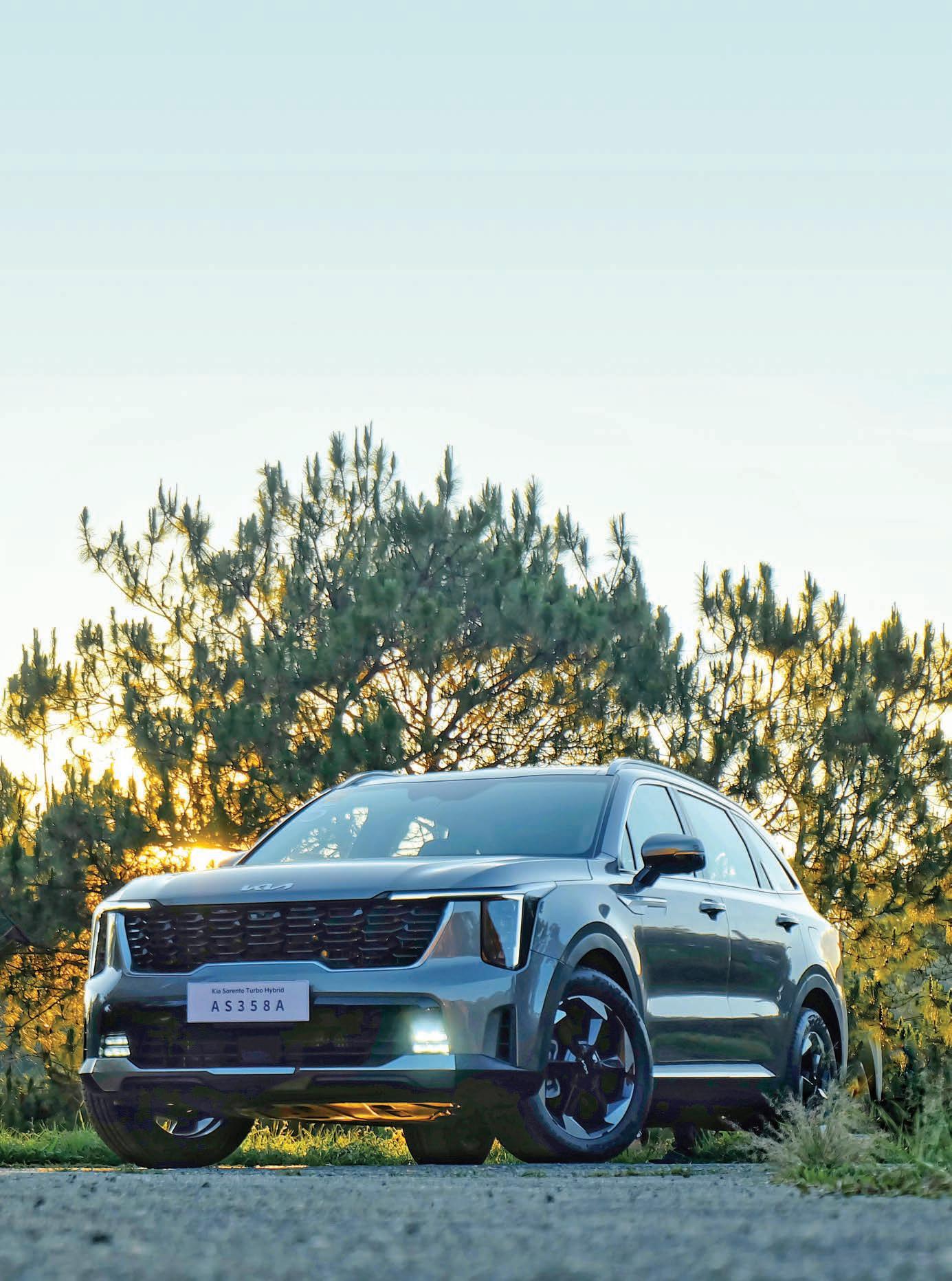
includes Smart Cruise Control System w/ Stop and Go, Blind Spot View Monitor, Lane Keeping Assist, Lane Follow Assist, Forward Collision-Avoidance Assist, Parking CollisionAvoidance Assist, 360-degree Surround View Monitor, Rear Blind Spot Collision Avoidance Assist (SX), and Safe Exit Warning (SX).
Neil: The Kia Sorento SX AWD Turbo Hybrid is priced at PHP2,888,000 and is near the top end of the price range for its category, but what it does offer is a lot of creature comforts, space, active and passive safety, and good looks. While we were only assigned two to a vehicle on this drive, you can load up with friends or family, luggage, and know that you won’t be wanting for power on the road, especially on road trips that put vehicles to a well-roudned test like Baguio.
RANDY PEREGRINO AND NEIL PAGULAYAN
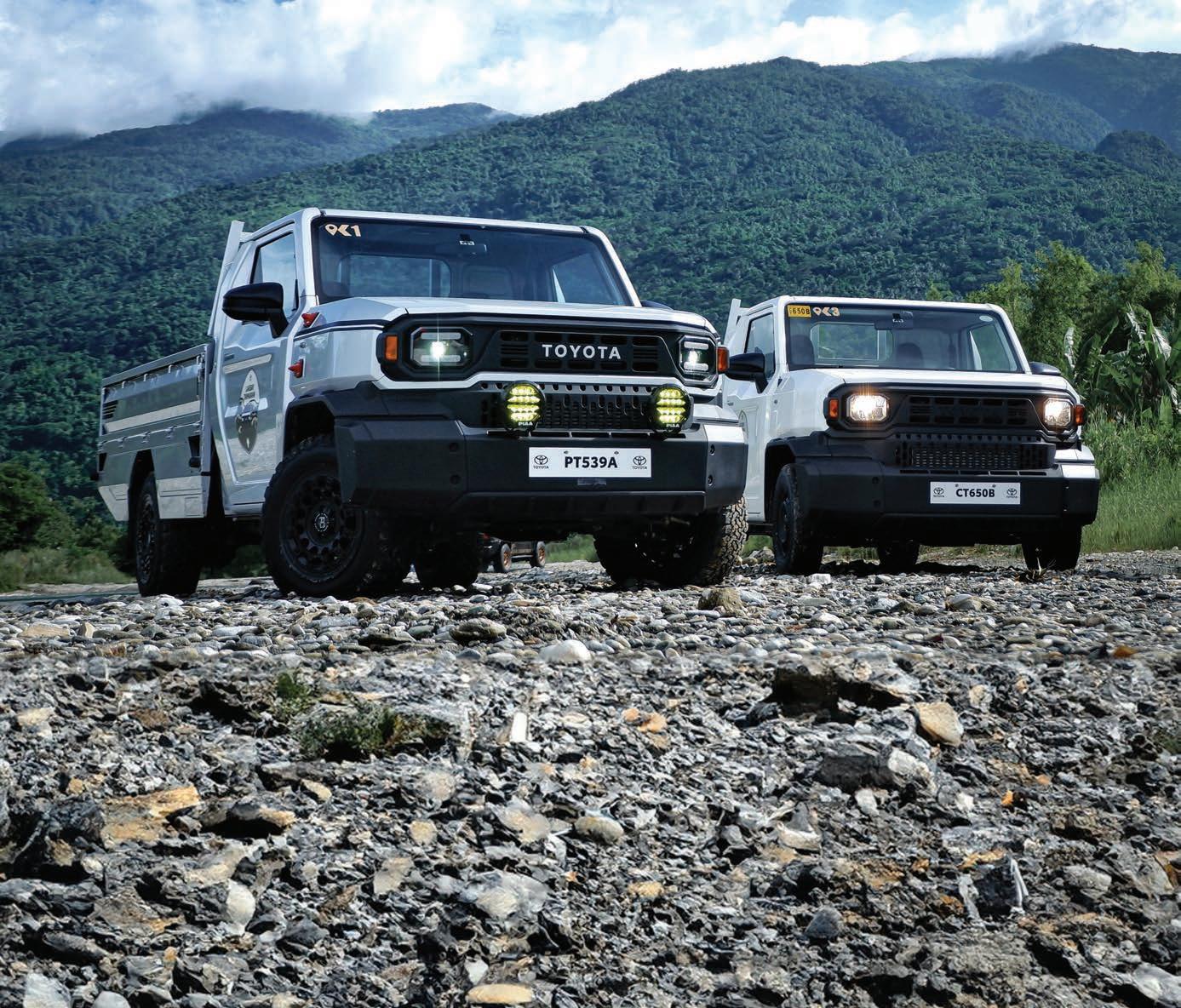
Return To Its Native Land Lakbay Tamaraw
The Tamaraw made a highly celebrated comeback in late 2024, and memories of encounters with this iconic nameplate all came back. Whether it is about family, business, or simply personal, the utility vehicle has been part of every owner’s life. Anyone who grew up in the ‘80s and ‘90s has their own story to tell, whether about ownership or simply the experience of riding one. Indeed, from the original bare-metal commercial and passenger vehicle to the three-row FX model, these generations of models truly left a mark on the country’s mobility history.
So, when Toyota Motor Philippines (TMP) invited us to participate in the “Lakbay Tamaraw” drive event, we knew it would be worthwhile. The destination? Of course, to its native origin land, Mindoro.
Old and new
Everything kicked off at the Batangas port where the entire group boarded the RoRo vessel bound for Calapan, Mindoro with all the commissioned GL Dropside variants (LWB and SWB). Most participants were assigned to the turbocharged diesel variants. But we got to test the gasoline SWB (short

wheelbase) M/T version. Considering the Tamaraw’s history of gasoline-powered models, it was a perfect assignment. Motivation comes from a 2.0-liter 1TR-FE, four-cylinder gasoline engine generating 137 hp and 183 N-m of torque mated to a fivespeed manual gearbox.
The Next Generation Tamaraw is built on Toyota’s global IMV platform, retaining the same DNA as the Tamaraw that plied Philippine roads in the 1990s and early 2000s. For us, it was like blending old and new elements to form an immortalized version. The bare frame has modern dark trims upfront and a spartan plastic dash and center console. Other modern features are 2DIN screen infotainment, a charging port, and cupholders. We love the manually controlled via crank handles.
After reaching Calapan port in Mindoro, we went for a short drive to the Toyota
dealership. There, we lined up all the Tamaraws and received a warm welcome from the local community. From the dealership, the group made a couple of side trips. First, we went to the shallow riverbed in Baco, underneath the Mangangan bridge for a photoshoot. There, we got to appreciate the new imposing look of the Next Generation Tamaraw dressed up with several aftermarket components. No wonder new owners are drawn and inclined to dress up this utility vehicle.
Drives even better
The next leg was the real deal in terms of the driving dynamics. Here, we got to experience the long provincial road and the notorious series of tight bends on Calapan National Road going to the Infinity resort in Puerto Galera. We were fair-minded in terms of expectations, particularly its overall comfort and handling, considering how the vehicle was built. But boy, we were so wrong. First, the seating orientation is a huge plus for a utility vehicle. The steering helm is higher and facing the driver directly, a car-like setup. Never mind if the two-seater bench has limited adjustments. There is enough legroom for a relatively tall guy. On the road, we waited for the usual noises from a bare frame, but there was very little to none. Even the engine noise is relatively muffled. For a rigid leaf-sprung rear suspension setup, bounces were expected. But not for the New Tamaraw because even with an empty cargo bed, it was somehow mild and tolerable.
At higher speeds, the vehicle was surprisingly well-planted and stable. Sure, the gasoline engine is less aggressive compared to the turbocharged diesel mills. But it does the job when pushed with constant downshifting, whenever the situation calls for it. Do not even start to ask us about the handling, because we were taken aback. In zigzags, it can keep up with

the more powerful A/T variants. Here, we were wondering if we were still driving a utility vehicle. Because of the firm damping setup, the Tamaraw responded well to tight turns. Rolling on smaller 14C steel rims wrapped in 195-series tires also helped. Together with good steering feedback, we only focused on when to brake and steer correctly. Entering and exiting those tight bends were never easier in a commercial vehicle. This New Tamaraw drives and handles well on winding roads, surprisingly even better than most new pickups. There, we said it.
Giving back to the community
Back at the dealership, we met the representatives of the Tamaraw Conservation Program (TCP). Established in 1979 as a special project under the Office of the President, it was then transferred to the Department of Environment and Natural Resources (DENR). The TCP’s ultimate goal is to grow the Tamaraw population to over 2000 and no longer consider the buffalo as a critically endangered species.


More importantly, there are the Bantay Tamaraw indigenous people volunteers and barangay volunteers who patrol the protected areas and deter illegal poachers. After launching the Next Generation Tamaraw, TMP signed a Memorandum of Understanding (MOU) with the DENR to support the TCP.
The second day was dedicated to a meaningful visit to Pagturian Mangyan School in Puerto Galera. This time, the utility vehicle served its important task – to carry all the donated school supplies and chairs. It was also the time to showcase not only the vehicle’s payload capacity but also the ease of loading and unloading, thanks to the rear bed dropside feature. Of course, the tight and steep climbs en route to the remote school did not stop the select LWB variants from fulfilling the important mission.
Legacy
The event’s first day may have given us the biggest surprise in a utility vehicle’s ability to drive and handle well. But the following day showed us what the Next Generation Tamaraw is all about. While the Tamaraw’s comeback as a commercial vehicle is a homage to its roots as a tough, reliable, and no-nonsense vehicle built for Filipinos, it also promotes the symbol of hope for conservation and, carries loads that put big smiles on children’s faces.
RANDY PEREGRINO
The first-ever VinFast drive event

Randy: For the first time, Vinfast Philippines recently hosted a media drive event showcasing its entire local lineup, including the recently launched VF 6 all-electric subcompact SUV. Commissioned along the VF6 were almost the entire roster of EV models currently offered in the country, the VF5, the VF7, their flagship SUV, the VF9, except for the smallest VF3.
Rather than venturing into the usual demanding itinerary, Vinfast Philippines opted for a relaxing drive to Tagaytay. No technical tests, just to enjoy the all-electric experience. Assigned to our group was the VF6 Plus variant.
Torino design
Vinfast claims that the design was developed in collaboration with the renowned studio Torino Design. The VF 6 features a concept inspiration of “The Duality in Nature,” emphasizing unique styling, which reflects the vehicle’s spirit and personality. Still, the brand’s distinctive and unmistakable design language is evident. Like the front end, which features the familiar two long silver trims with the “V” logo in the middle. Those LED headlamps, positioned lower, can almost be mistaken for fog lamps. But overall, VinFast’s fascia design cues are one of the easiest to recognize on the road for the keen observer.
The rear end has the same prominent cues, only instead of a metal finish, the lines
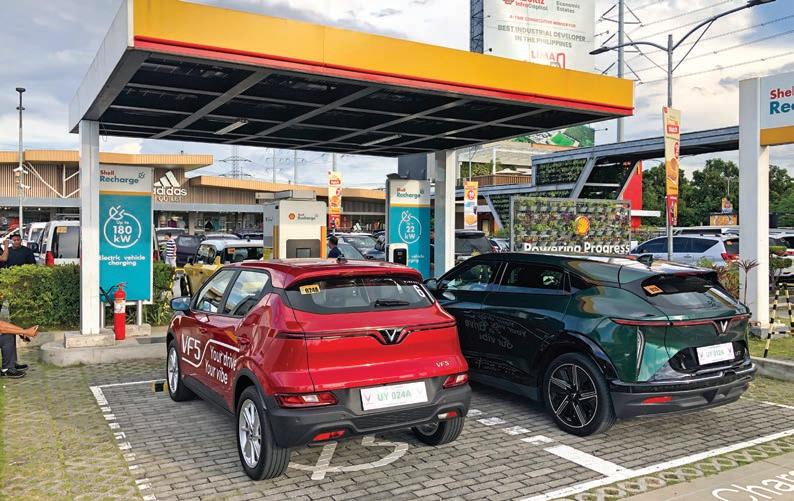
are red and aligned with the taillights. The vehicle’s overall dimensions are 4,241mm long, 1,834 mm wide, and 1,580 mm tall, with a wheelbase of 2,730 mm. According to Vinfast, the advantages of EV architecture in this B-segment vehicle offer an interior space comparable to that of many C-segment gasoline models.
Inside, it is neat and streamlined, highlighting only the center 12.9-inch touch-operated screen, which houses all the vehicle’s tech controls and settings. Drive information is visible via a reflection display
at the lower front windshield, leaving the center touchscreen as the lone physical display unit. The dark-themed interior features soft-touch materials and plastic trims. The sporty seats are leather-wrapped with visible orange stitching. Metallic trims are also present on the dash, extending to the door sidings and accenting the center console. Instead of the usual shifter, Vinfast clustered the drive controls just below the center air-con vents.
One of the ways to determine a vehicle’s intuitive interior design and easy operation

is to deliberately not rely on manuals and just hop in and see what happens. Yes, the cabin is neat with little to no physical buttons, but it was a letdown that it took longer than usual to find the side mirror controls in the center screen display. It should not take several taps or swipes to locate the control itself. While every driver only needs to discover it at first instance, the software interface could have been better.
All that electric power and safety
Motivation comes from an electric motor generating up to 201 hp and 310 N-m of torque. The drive range is up to 480 km per full charge (NEDC standard). The fastcharging feature can achieve a 10-70 percent battery level in just 25 minutes. On ECO mode, it only takes 10.5 seconds to reach 100 km/h. Regarding safety, the vehicle features 20 advanced driver-assistance systems (ADAS) and eight airbags, providing added peace of mind.
Tamed yet aggressive when summoned
As we left VinFast EDSA, we found the VF6 behaves like any subcompact EV in terms of stability, comfort, and even noise level. Steering response is also good on curves and during overtakes on the highway. Switching between available drive modes has an evident impact on acceleration. We appreciate that in ECO mode, the response
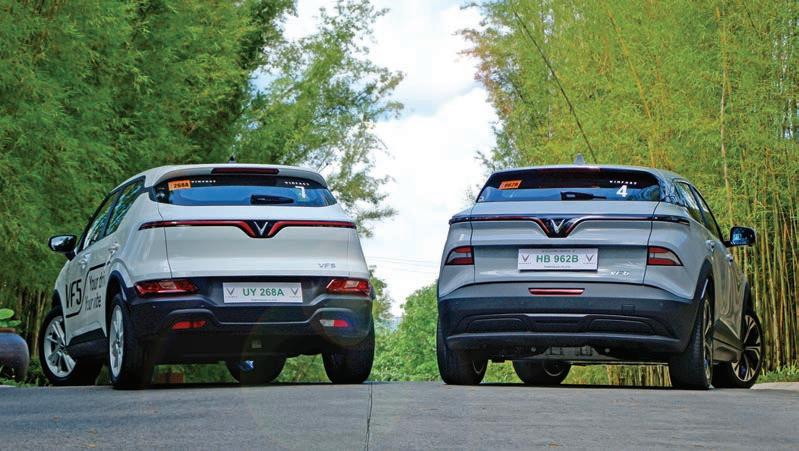
is subdued yet substantial, providing torque when needed, which is ideal for city driving. But on SPORT, the electric motor becomes more aggressive on acceleration. This setting maximizes the staggering torque available to push the small frame. Even so, an essential element was missing during the freeway run – the absence of regenerative braking.
Neil: As I was seated in the backseat, I found the dimensions to be adequate for a person of my stature, about the average-sized Pinoy. But Fort, who drove on the way up to Tagaytay, found the second row lacking for six-foot-tall people like himself. I noticed that the floor was raised, I assume because that was where the battery was housed. But in the whole I managed to find a comfortable seating position and enjoyed the ride as headed south of Manila,
As I was enjoying the ride, my two car mates, Randy and Fort were arguing over whether the VF6 had regenerative braking, but since there seemed to be no buttons on the dash and the menu on the infotainment screen seemed to confuse them they just drove on to our first stop. When we got to Nuvali, for a quick stop, I tried my hand at resolving the issue. I found the settings for the regenerative braking in the same window on the infotainment, but was an additional swipe left after the side mirror
adjustment. Hopefully, on the next part of the drive, there’d be no more arguing.
Randy: Neil found the regenerative braking settings and showed us. We discovered the regenerative braking was switched OFF by default, which is always the case. It was only during the Aguinaldo highway run that we utilized the regenerative braking function. With an 80 percent charge level from the dealership in EDSA, we reached the resort in Tagaytay with still over 60 percent charge level.
Neil: At Tagaytay, we had lunch and did some work, taking photos of the VinFast vehicles we had driven. It was hot and most of the cars had run down some of their charge as the vehicles were running and had their air conditioning left on. So on the way back, we stopped at the Shell station along the southbound lane of SLEX to take advantage of their fast charge (DC) facilities.
Randy: Traveling to Tagaytay back and forth with an 80 percent charge level was more than enough battery juice to enjoy the trip.
The VF6 Plus variant is priced at P1.610 million. In terms of after-sales service, the VF 6 comes with one of the most competitive warranties in its class: 7 years or 160,000 kilometers, whichever comes first.
RANDY PEREGRINO AND NEIL PAGULAYAN

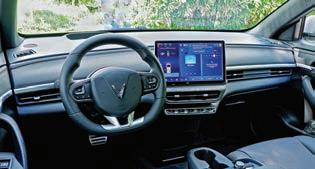

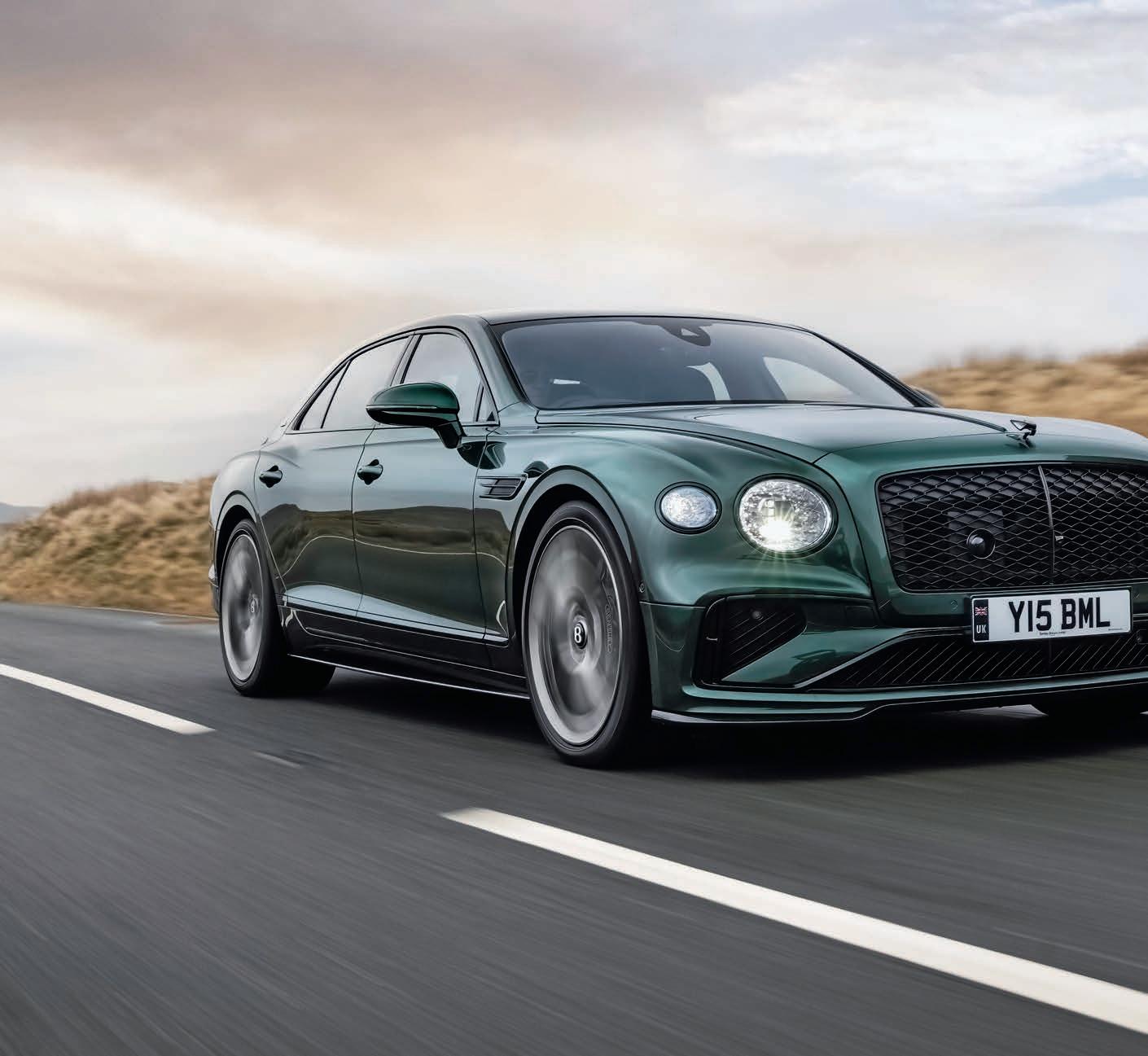
ROAD TEST 5750
BENTLEY FLYING SPUR
Super-saloon begins post-W12 era with even more power and luxury
Zuffenhausen old boy and recently installed CEO at Bentley Motors, the estimable Frank-Steffen Walliser, recently spoke to us about making “something more extreme”.
Settling into his new role after 29 years with Porsche, the German was hinting at future models that could bring added excitement to the traditional Bentley way of doing things (911 GT3 RS treatment for the Conti GT, anyone?), but he could just as well have been talking about the super-saloon he’s just launched. You’re looking at the latest Flying Spur, which now comes exclusively in V8 hybrid flavour and with no shortage of horsepower in any form, but especially in
top-billing Speed guise, as we have here. This car puts out as near as dammit 800bhp and thus comfortably outguns its 6.0-litre W12 predecessor. The old Speed had to make do with 626bhp, a figure that hardly needed a bump of nearly 25%, but when electrically generated power comes relatively easily, why on earth wouldn’t you?
It’s a thought-provoking level of shove for a car that, despite its quietly driver-oriented bent, will serve most owners purely as a luxury conveyance, shuttling them about the world’s more salubrious postcodes in comfort and style. And, more than ever, in silence. Launched in tandem with the new Continental GT – also a PHEV –the revised Flying Spur has an
official electric range of 47 miles, which is almost double that of the previous car. This ought to play to the Spur’s strengths in a way that perhaps eludes its more sporting coupé sibling, though as ever does come with a considerable weight penalty. At 2571kg the PHEV Speed is the heaviest Flying Spur to date, and it’s this, along with the fact that the W12 is now off the menu on legislative grounds, that may explain why Bentley has chosen to launch its ‘four-door grand tourer’ with headline-grabbing figures of 772bhp and 738lb ft. There is, of course, rather more to this car than epic power and torque, so let’s find out if the fastest, most advanced Spur yet is also the best.
DESIGN & ENGINEERING
PROS V8 alive and well in the new PHEV Spur; inimitable presence CONS Even heavier than claimed
The Flying Spur hasn’t adopted the new bladed headlights seen on the revamped Continental GT and so it isn’t quite as simple to identify a facelifted car from the original Mk3 launched in 2019. Indeed, in terms of exterior design, it’s 95% unchanged from before, with the classic quad-headlights kept on. The big news is the Speed’s adoption of Bentley’s ‘Ultra Performance Hybrid’ powertrain, which sees a 188bhp, 332lb ft permanent magnet synchronous motor sit between an
MODEL TESTED
BENTLEY
FLYING SPUR
SPEED FIRST EDITION
Price £226,500
Power 772bhp
Torque 738lb ft
0-60mph 3.2sec
30-70mph 2.7sec
Top speed 177mph (claimed)
Average economy 22.0mpg
Electric range 44 miles
CO 2 emissions 33g/km
70-0mph 41.5m (10deg C, dry)

eight-speed dual-clutch gearbox from ZF and a 592bhp, 590lb ft 4.0-litre twin-turbo V8. Though similar on paper, this isn’t quite the same V8 that has appeared in the Flying Spur in the past, not least because it no longer features cylinder deactivation and switches to mono-scroll turbochargers rather than the twin-scroll blowers used previously. That new-found electrical assistance negates the need for either tech, providing both all-electric running capability and so-called torque-fill that provides response while the turbochargers are spooling up.
The motor is fed by a 25.9kWh battery, 43% larger in capacity than that used for the old V6 hybrid Spur,
Flying Spur retains plenty of solid-feeling switchgear on both the transmission tunnel and the wheel spokes. Few cars now offer such easy control in the cockpit.
Speed grade has sporty veneers such as the turned aluminium seen here or high-gloss carbon. Mullinerand Azure-spec Spurs can be had with wood, among other materials.
More car makers would do well to imitate Bentley’s approach to mode selection: slot the rotary dial to ‘Bentley’ mode for the engineers’ optimum set-up.
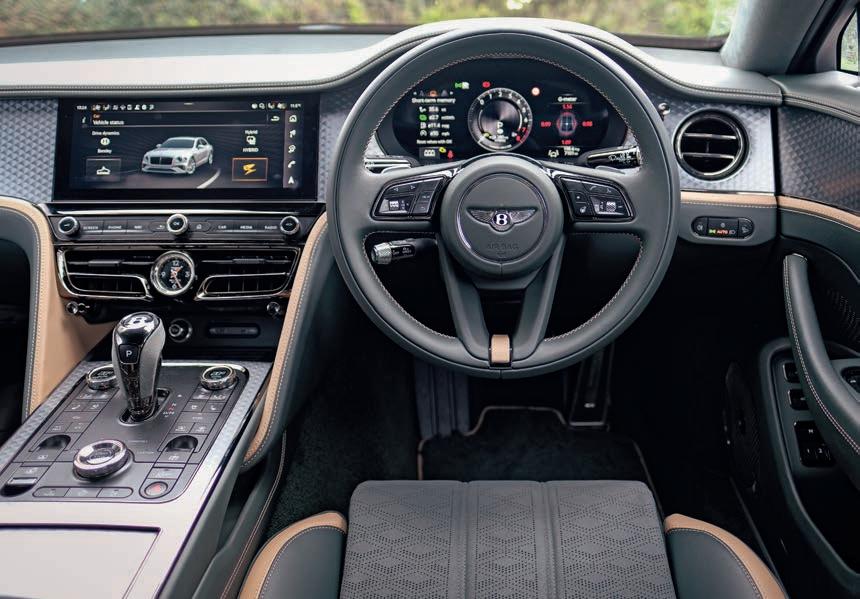
but still found under the boot with an attached 48V loom to drive the active anti-roll bars, rear steering and three-chamber air springs. If you think all that sounds heavy, you’d be right. The V6 hybrid Spur we tested in 2022 weighed 2596kg with its 80-litre tank full, and the new car – with its extra cylinders and battery capacity – sees that figure grow to 2750kg, though the neat 48:52 front-to-rear distribution hasn’t gone anywhere. The Bentley comes in nearly 100kg heavier than the similarly conceived, similarly lavish and similarly V8 hybrid Mercedes-AMG S63 E Performance. The new Speed’s contact patch is commensurately epic, especially in the context of a fast saloon.
The combination of 315-section rear Pirellis and 275-section fronts is identical to that of the Continental GT (the new BMW M5, for reference, is booted with 295-sections at the back), ensuring that the AWD system has plenty to work with.
The Flying Spur also gets a version of the new twin-chamber air springs already seen on the Conti GT (the old cars used a triple-chamber spring), which are said to offer even greater control over rebound and compression movements. There’s a new calibration for the ESC, which works alongside the car’s electronically controlled limitedslip differential and brake-based torque vectoring across the axle.
INTERIOR
PROS Material lavishness few others can match; space; solid switchgear CONS Hybrid system eats into boot space
Bentley has resisted the temptation to maximise digital real estate for this facelifted Spur, and the cockpit is as fabulous to be in as ever, managing to come across as both sporting and opulent in a manner no other car maker quite achieves. Naturally it’s very similar to that of the new Conti GT, and as with that car the Speed gets darker brightwork and black matt plastic that feels impressively expensive. Our test car’s turned-aluminium trim certainly caught the eye as well, and it’s also possible to have the Spur with a Côtes de Genève finish, which looks spectacular. Take it as read that the Spur ticks every box for ergonomics, comfort and oddment storage, and there are also plenty of USB-C ports. In the back, by our tape measure the Spur’s leg room isn’t quite as generous as the Rolls-Royce Ghost’s, but this is academic because both cars are supremely capacious. If you opt for the four-seat configuration, the Spur has the sweeter-sculpted rear berths. They come with Auto Climate, which monitors the humidity and temperature of the surface and adjusts the heating and ventilation to maintain comfort. ▶

■ You can quickly identify the Speed because of its dark brightwork, which extends to the retractable (and illuminated) ‘Flying B’ at the prow of that endless bonnet.

■ The updated Continental GT has a striking new headlight design but the Spur retains the old style, with four roundels and the rather lovely cut-crystal effect behind the lens.
WHEEL AND PEDAL ALIGNMENT A Steering offset 5mm left B Brake offset 60mm right C Accelerator offset 190mm right. Driving position has a very slight offset but not enough to irk. Otherwise? Commanding.

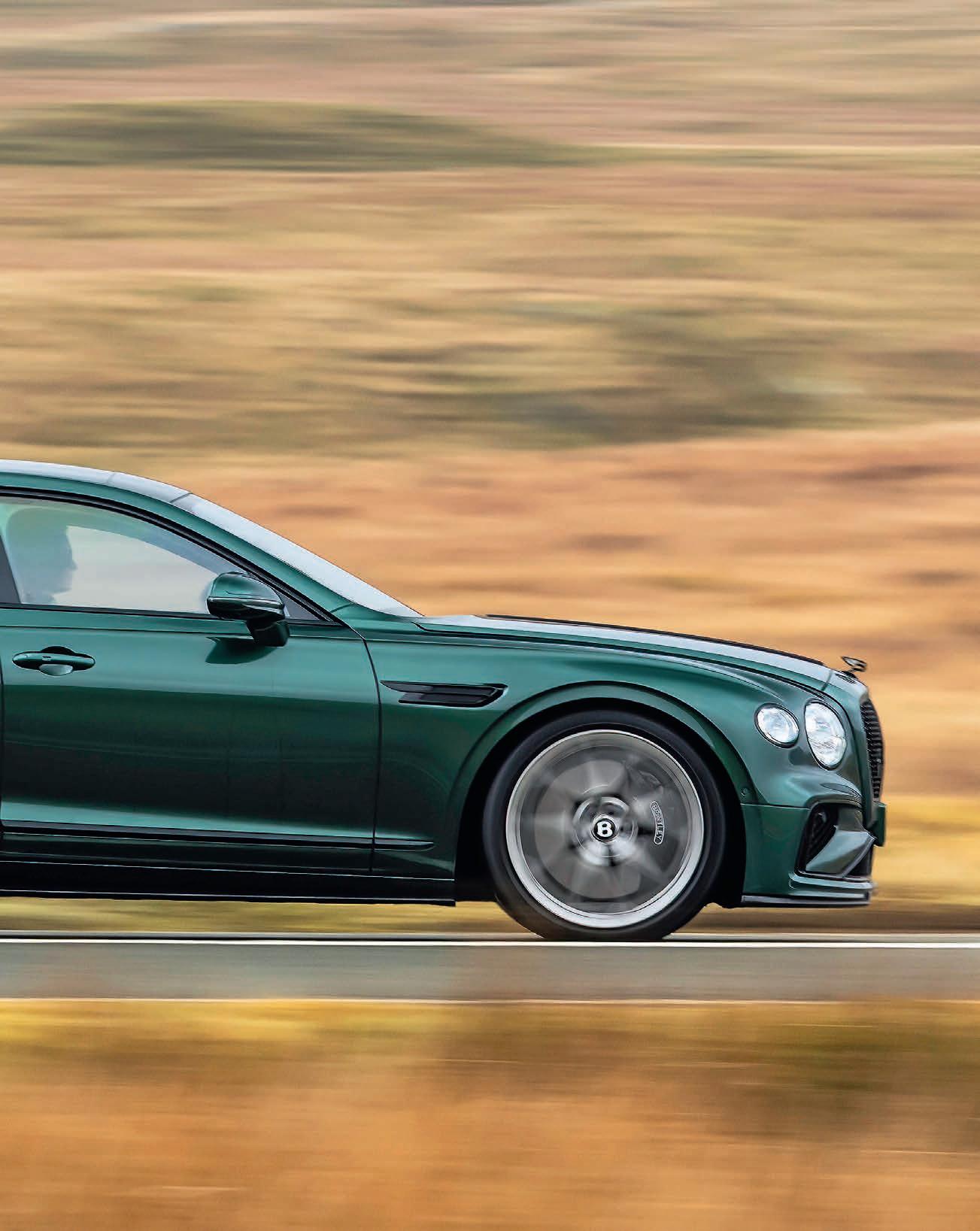
“And what about luxury? There’s no shortage of it, especially at higher speeds, where the Spur is, quite simply, majestic. ”
TEST RESULTS
DIMENSIONS
RUNNING EFFICIENCY WLTP 202mpg (combined) Test range 387/470/450 miles (average/touring/everyday) Electric test range 44 miles

CABIN NOISE
MANUFACTURER’S SPECIFICATION
BENTLEY FLYING SPUR
SPEED FIRST EDITION
On-the-road price
£226,500
Price as tested £291,390
Value after 3yrs/36k miles £132,700
Insurance group 50
HYBRID POWERTRAIN
Engine Front, longitudinal, 4WD
Type V8, 3996cc, twin-turbo, petrol; 592bhp, 590lb ft
Motor Permanent magnet synchronous motor, gearboxmounted; 188bhp, 332lb ft
Battery 25.9/22.0kWh (total/usable)
Total power 772bhp
Total torque 738lb ft
Power to weight 300bhp per tonne
Torque to weight 287lb ft per tonne

GEARBOX
Type 8-spd dual-clutch auto rpm in top gear at 70/80mph 1336/1527
CHASSIS & BODY
Construction Steel and aluminium monocoque Weight/as tested 2571kg/2750kg Wheels 9.5Jx22in (f), 11.0Jx22in (r) Tyres 275/35 ZR22 104Y (f), 315/30 ZR22 107Y (f), Pirelli P Zero Fuel tank 80 litres
SUSPENSION & STEERING
Front Double wishbones, air springs, active anti-roll bar Rear Multi-link, air springs, active antiroll bar Steering EPAS, rack and pinion; 2.4 turns lock to lock; 12.4m turning circle
“At higher speeds, the Flying Spur is, quite simply, majestic”
◀ Postural Adjust then uses a number of air cushions to subtly vary the pressure on your legs and back throughout the journey. It is, in short, a wonderful place to let the miles go by. Elsewhere, one thing to note about the PHEV Spur is that boot space is compromised, on account of the battery back. It falls from 420 litres in the regular V8 car to just 346 litres, some of which is then taken up by the charge cable case.
PERFORMANCE
PROS No shortage of pace; electric portion generally well integrated CONS Soft brakes; unintuitive regenerative braking calibration
In mechanical terms, the Bentley’s most direct rival is Mercedes-AMG’s formidable 791bhp V8 hybrid S63 E Performance. Though less powerful, if only by a whisker, and heavier, the Brit is still the quicker car off the mark, needing just 3.2sec to surge to 60mph versus 3.5sec for the Merc. Indeed, the four-door Bentley trails its coupé sibling only by a tenth, though the gap does grow as speed piles on, and by 150mph the Spur is a good few car lengths behind the Conti GT Speed. All three are monstrously quick. In terms of character, electric assistance gives the Spur rather a profound duality. On one side there’s all-electric running, and that certainly suits this lavish limousine, even if the performance on offer is modest, and best deployed mainly in urban environments.
Then, of course, there are those moments of full-throttle attack, when the bassy V8 makes itself fully known, and the meat of its torque delivery is faintly heralded by some electric torque-fill, which as you would expect gives the Spur cleaner accelerator response than it has ever known. This is true whether you’re asking for everything this powertrain has or you just want to indulge in gentle roll-on shove. Certainly, the calibration of two power sources is more neatly managed here than in the AMG.
At least, it is for acceleration. The regenerative element of the braking system gives the pedal a softer, less precise action than you’d expect from a performance brand like Bentley, and its predictive actions –slowing the car down automatically for traffic and roundabouts etc – don’t chime with the thick-set, linear, intuitive sense of control associated with Crewe’s wares.
RIDE & HANDLING
PROS Supreme stability; easy to place; confidence-inspiring CONS Cornering poise not as natural as some; low-speed ride
The Flying Spur Speed doesn’t have the incisive handling of its cousin, Porsche’s Panamera Turbo
E-Hybrid, and neither, frankly, would you want it to. Its cornering balance is steady and uneventful, majoring more on insouciance than engagement, with plenty of stability on offer, aided by that vast wheelbase and enormous contact patch. There’s accuracy too. The ease with which the Spur can be placed can be confounding at times, especially when the suspension control is at its tightest, when body roll is neatly managed but never locked down needlessly tightly. We can’t help feeling there’s more to come here, though. The steering – sweetly sped, nicely weighted –would benefit from a stronger sense of mechanical connection. And while it sounds fatuous to say it of a 2.7-tonne, 5.3m-long limousine, a little more intent in the handling balance wouldn’t go amiss. After
all, we know what Bentley is capable of, and while the Spur is broadly speaking the most engaging car in the super-luxury saloon segment, there are times when an S63 E Performance scythes through bends with just a little more poise. This is, after all, a Speed derivative. And what about luxury? There’s no shortage of it, especially at higher speeds, where the Spur is, quite simply, majestic. A noise recording of 61dBA at 70mph beats that of even the pure-electric Mercedes EQS 450+ Business Class. The Bentley is exceptionally quiet, and supremely cosseting. Its only slight failing concerns lower-speed ride quality on more threadbare surfaces. Perhaps the Speed’s 22in wheels are to blame, but on occasion the Spur just wasn’t as unruffled as expected.
BUYING & OWNING
PROS Decent EV range; usefully undercuts Rolls’ Ghost on price CONS Options really do add up
The Flying Spur Speed starts at £226,500, making it around 10% more expensive than the preupdate, W12-engined Speed, and things can escalate from there –this car has £60k of optional extras. Even so, the car seems reasonably priced, splitting AMG’s S63, which it trounces for materials quality, and the Rolls-Royce Ghost above it (opt for a £244k-plus Mulliner-grade car to have the Spur at its most lavish). Chauffeurs driving in and around cities can expect to return around 2.0mpkWh, for an EV range of 44 miles. For touring duties, expect 470 miles or so from the 80-litre tank.


In the past, if you wanted your Bentley limousine with EV capability, you needed to settle for a V6 under the long bonnet. With this update, the Flying Spur loses the option of W12 power but gains a considerable amount of real-world electric range and pairs that with a charismatic V8 guaranteed to put a smile on your face. All said, we consider that a good deal for customers: the Spur is now a quicker, more versatile car than ever – and an expanded range of interesting, wonderfully tactile interior trim certainly doesn’t hurt its case. Only a couple of slight dynamic foibles blot its copybook.


MOTORSPORTS
Unforgettable Adventures and Epic Scenic Escapes
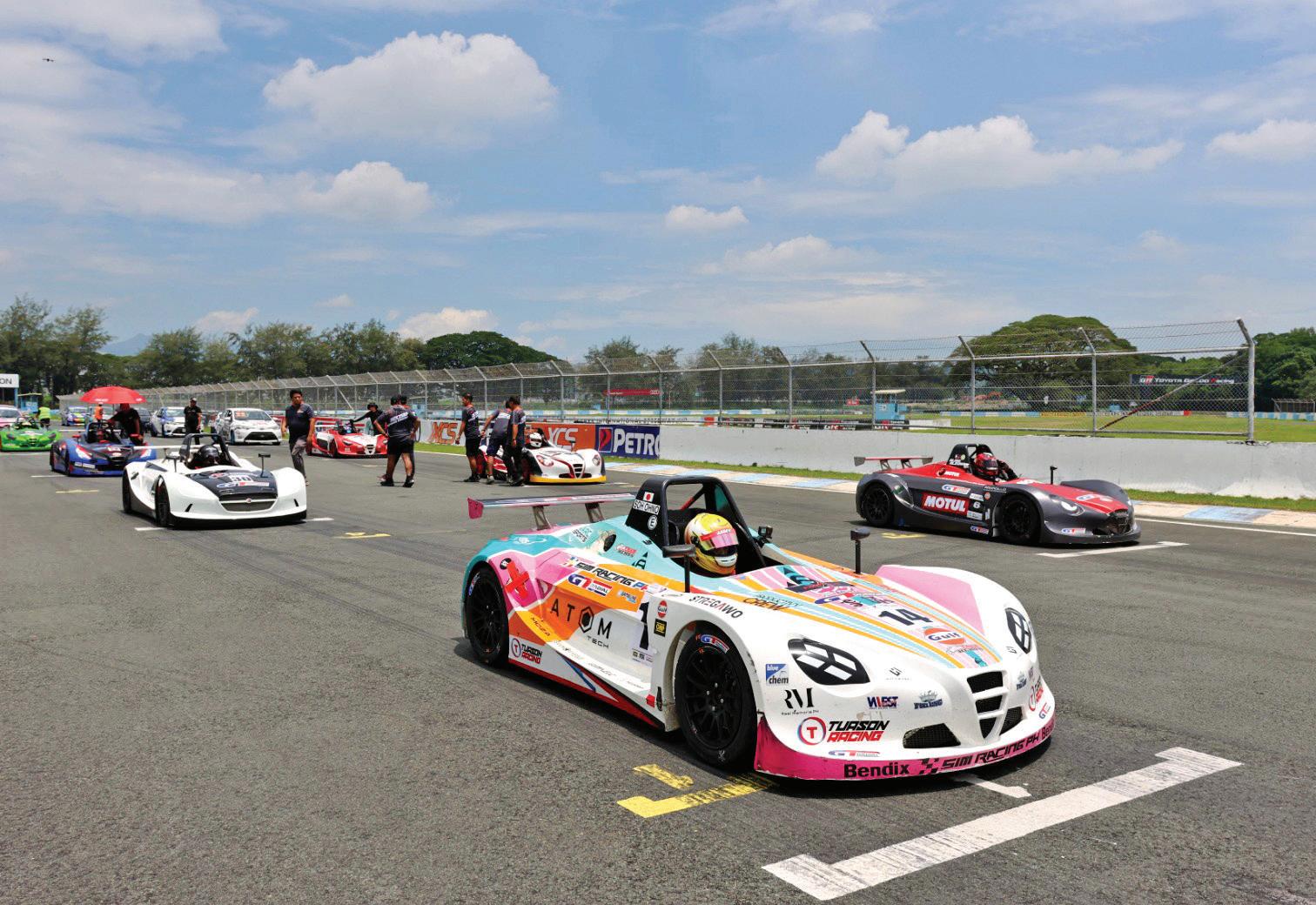
2025 FORMULA V1 UNITY CUP ROARS INTO ROUND 2 AT CLARK
Tuason Racing recently held its second staging of the 2025 Formula V1 Unity Cup, its grassroots racing series in partnership with GT Radial Philippines. The thrilling race happened last June 14 at the 4.2 km long Clark International Speedway (CIS) in Pampanga, where purpose-built Formula V1 racecars piloted by rookie, intermediate, and seasoned racing drivers battled it out for the win.
Notable key figures in the international racing scene have graced the occasion, making for what was a memorable weekend for the racers and organizers alike. These include renowned Japanese racing driver Kiyoshi Misaki. West Racing, the company behind the research and development of the Formula V1 racing machine, also sent representatives to witness the action unfold.
And then there’s Son Ohno, a 64-year-
old Japanese race car icon who claimed multiple recognitions in various racing disciplines, including endurance race wins and a 2nd place finish in the Vita Gentlemen Class at the renowned Suzuka Circuit. The Vita is the Japanese counterpart to the Formula V1 challenge here in the Philippines.
Tuason Racing says these international guests’ continued support and belief

in Filipino talent “underscore a shared vision: elevating the V1 Challenge to be recognized in the Southeast Asian Region.”
Ohno-San would eventually shine through with a victory in both the first and second races of the weekend. In the morning, Ohno-San outpaced celebrity and professional racing driver Troy Montero, who secured a commendable second place. Alain Gabriel Alzona rounded out the podium trio with a respectable third.
The afternoon saw the second heat commence, with Ohno-San repeating an exceptional effort to claim first once more. The Japanese racing driver’s victory #2 was not without a challenge, though as Filipino racer Bryan Co saw it through to claim a very close second place, exhibiting a calm yet cunning drive. Andre Rodrigues completes the top three, underscoring his rising status as a future Formula V1 rockstar.
MAZDA PH DEBUTS MSCC MAZDA DRIVER DEVELOPMENT PROGRAM AT 2025 KALAYAAN CUP
The second round of the 2025 Petron Makabayan Endurance Race, held at the Clark International Speedway, served as the debut venue for the MSCC Mazda Driver Development Program—an initiative aimed at cultivating young motorsport talent through real-world competition and mentorship.
Mazda Philippines, in collaboration with Windy Imperial, officially rolled out the program through Bermaz Team 09 and a specially prepared MSCC Miata Spec race car. The initiative places focus on developing future champions by exposing them to the demanding environment of endurance racing.
The #09 entry, piloted by up-andcoming talents Javier Toledo, Jeff Balao, and Enzo Celestino, completed an impressive 279 laps and secured a second runner-up finish in the combined six- and twelve-hour Kalayaan Cup. Despite the car originally being built for 30-minute races, it was modified with critical upgrades—such as Winmax brake pads, Cusco suspension, GT Radial SX-R
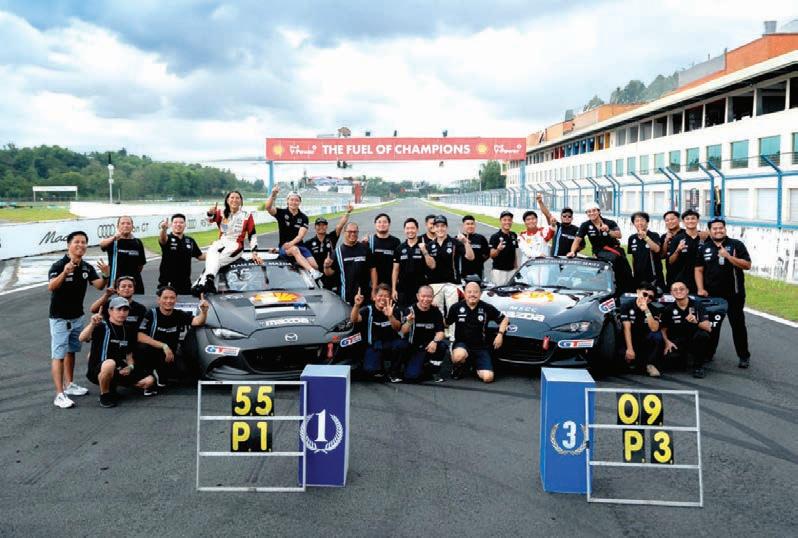
tires, and Concept One wheels—to handle the endurance format.
The top-performing #55 MSCC Miata Spec, led by seasoned racer Angie Mead King, dominated both the six- and twelvehour races, completing 293 laps with a best time of 2:07.255. This result built

on the team’s success from the previous round and showcased the effectiveness of strategic adjustments, including a new quick fuel system and optimized tire selection. The expanded five-driver roster—Angie King, Juha Turalba, Matt Solomon, Milo Rivera, and Tyson Sy— ensured a balanced and efficient race strategy.
Angie highlighted the value of teamwork, particularly when she had to withdraw mid-race due to a bout of vertigo. “We stuck to our strategy—push early, conserve in the middle, and push again toward the end,” she said.
Windy Imperial emphasized that the MSCC Mazda Driver Development Program aims to accelerate the learning curve of promising drivers by combining technical skill-building with racing discipline. “Endurance racing demands not just speed, but focus, maturity, and a deep understanding of vehicle dynamics,” he noted.
Both King and Imperial view their roles not just as drivers but as mentors dedicated to nurturing the next generation of Filipino racers.































QUIET CONFIDENCE
THE JAECOO J7 SHS BLENDS HYBRID TECH WITH EVERYDAY VERSATILITY SMART, STYLISH, AND SERIOUSLY EFFICIENT—THE
J7 SHS PROVES YOU DON’T NEED FLASH TO STAND OUT.
Words by Anjo Perez
In an age when SUVs often shout for attention with oversized grilles and overly aggressive styling, the JAECOO J7 SHS takes the opposite route—and ends up commanding attention anyway. It doesn’t try to dazzle you with drama. Instead, it earns your second (and third) look through elegant restraint, intelligent engineering, and a cleanly
executed design that just works. From the outside, the J7 SHS looks smart and sophisticated. Its smooth profile, rising beltline, and minimalist sculpting feel both contemporary and understated. Measuring 4,500 mm long and 1,865 mm wide, it slots perfectly into the compact SUV category, but its visual presence hints at something more premium. The slim chrome-accented grille and
LED headlamps set the tone up front, while tasteful character lines and a confident stance give it street cred without trying too hard. On top, a panoramic sunroof stretches nearly the entire roofline, letting in light and offering both rows of passengers a chance to gaze at the sky on weekend drives or late-night city cruises.
Step inside and the J7 SHS welcomes you with an equally

refined interior. There’s no overdesign here—just thoughtful, functional touches. The seats are upholstered in soft-touch leather with contrast stitching, and the clean dash layout centers around a crisp 12.3-inch touchscreen infotainment system that feels intuitive from the first tap. Metallic inserts and ambient lighting add subtle highlights to the cabin, while the 8-inch digital instrument panel provides

all the essentials without clutter. The cabin is also impressively roomy, thanks to a generous 2,672 mm wheelbase. Five adults can ride in comfort, with ample legroom and smart storage options throughout. The cargo area starts at 500 liters, but with the rear seats folded flat, it expands to a generous 1,265 liters—ideal for road trips, grocery hauls, or even weekend business runs for small entrepreneurs. Everything inside the J7 SHS feels built for both daily ease and long-haul flexibility.
Underneath all that subtle style lies its biggest selling point: the hybrid drivetrain.
Power comes from a 1.5-liter turbocharged engine, paired with a 150-kW electric motor and a 21.7 kWh lithium-ironphosphate battery. The system is smart enough to switch between gasoline and electric modes seamlessly, maximizing efficiency depending on your drive. On a recent 100-kilometer drive from Batangas to Makati, the J7 SHS used just a sliver of its range. It started with 510 kilometers of fuel and 75 kilometers of battery and arrived in Makati with 495 kilometers of
fuel and 20 kilometers of electric range still showing. That’s not just efficient—it’s intelligent.
Drivers can also choose Full EV mode, allowing up to 106 kilometers of electric-only driving (based on NEDC figures), perfect for daily commutes or school runs. And when needed, Forced Charging mode lets the engine recharge the battery while on the move—a useful feature when chargers are scarce.
On the road, the J7 SHS feels composed and confident. The suspension setup—MacPherson struts up front and a multi-
link rear—offers a refined ride without losing touch with the road. Whether in tight city corners or on wide expressways, the light but precise steering inspires confidence. Even regenerative braking, often a sore spot in hybrids, is smoothly tuned here, gradually feeding energy back into the battery without unsettling the driving experience.
The SUV’s practicality extends to real-world usability. It rides 147 mm off the ground (174 mm unladen), enough to handle gravel roads or steep village driveways. A 60-liter fuel tank

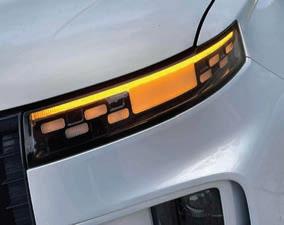

extends highway range, and with a braked towing capacity of 1,500 kg, it’s not afraid of heavier work when needed.
Tech-wise, the J7 SHS is loaded. Wireless Apple CarPlay and Android Auto come standard, along with a surprisingly punchy eight-speaker sound system. A head-up display, adaptive cruise control, 360° camera, lanekeeping assist, and blind-spot monitoring turn even stressful traffic into a more manageable experience. Seven airbags and a high-strength steel frame ensure safety is taken just as seriously as efficiency.
All this, for just under P1.6 million. That includes a five-year, unlimited mileage warranty and three years of free maintenance—an ownership package that makes the J7 SHS not just a smart hybrid, but a smart buy.
For the everyday Filipino driver—whether you’re a young professional, a family person, or even a small business owner needing both function and flair— the JAECOO J7 SHS offers a quiet kind of confidence. One that doesn’t rely on flash but instead delivers substance where it counts.
THE MITSUBISHI DESTINATOR ARRIVES, AND IT’S BUILT FOR ASEAN ROADS FROM CONCEPT TO REALITY
Born from the bold DST Concept, Mitsubishi’s newest crossover SUV brings turbocharged confidence, rugged design, and everyday tech to Filipino roads and beyond.
What started as a radical concept at the Philippine International Motor Show in 2024 has finally rolled into reality. After months of rumors, design leaks, and even patent filings, Mitsubishi has officially launched the production version of the DST Concept. Now known as the 2026 Mitsubishi
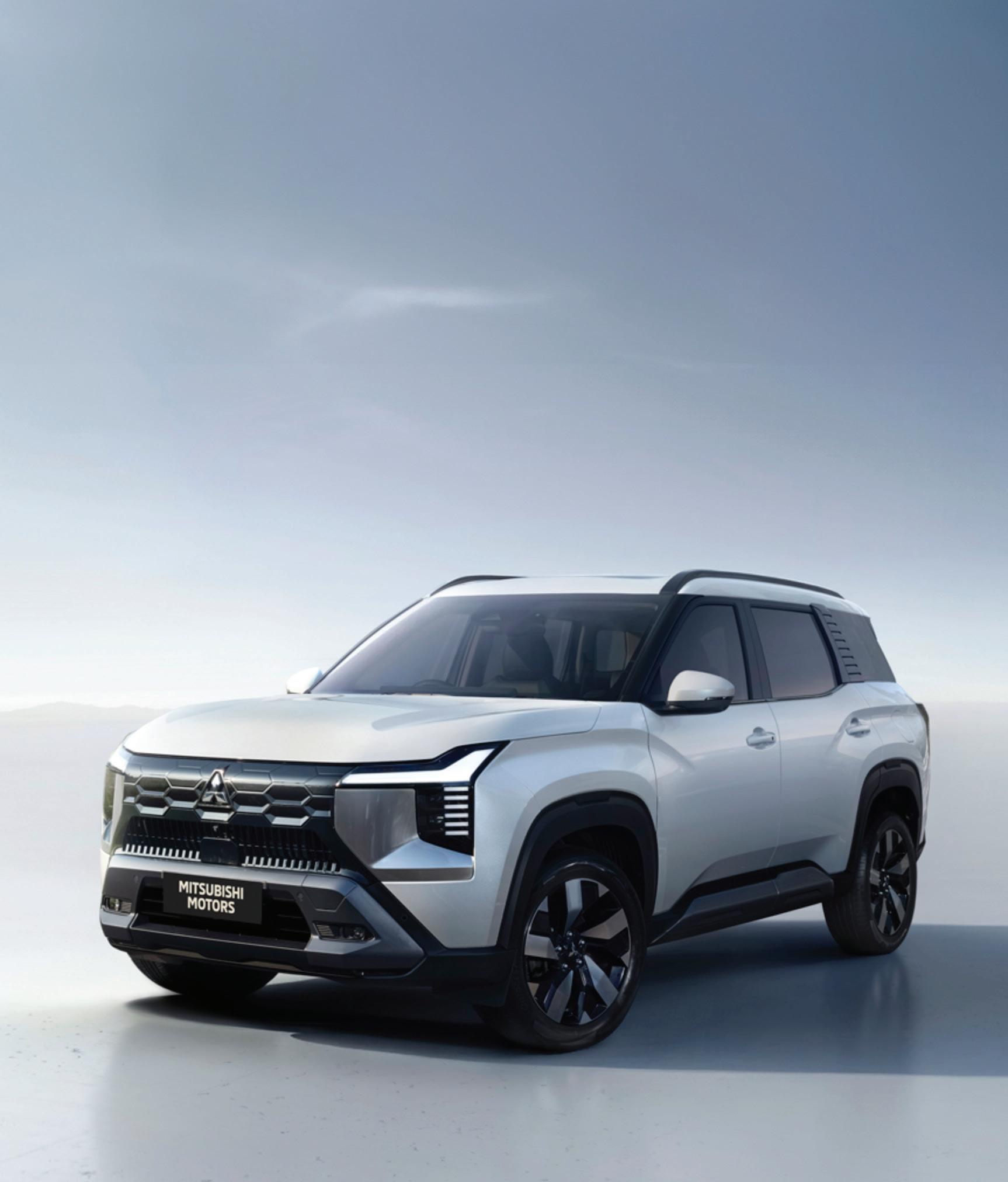
Destinator, this all-new compact crossover is designed specifically for the ASEAN market—with the Philippines expected to be one of its strongest territories.
While the Destinator shares its basic underpinnings with the Mitsubishi Xforce—both riding on an Xpander-based platform—it has been re-engineered from the ground up for tougher use. Mitsubishi tweaked the chassis and suspension tuning to better suit regional driving conditions like pothole-ridden provincial highways and flood-prone city streets. Its 214 mm ground
clearance adds more confidence for light off-road excursions or navigating sudden urban obstacles, while the inclusion of Mitsubishi’s Active Yaw Control system helps improve cornering stability even without all-wheel drive.
Under the hood, the Destinator carries a familiar yet capable engine: a 1.5-liter turbocharged four-cylinder sourced from the Eclipse Cross. This motor delivers 163 horsepower and 250 Nm of torque, paired with a CVT that drives the front wheels. The
combination offers smooth urban maneuvering and adequate punch for highway cruising, ideal for Filipino motorists who want both performance and efficiency without the fuel anxiety of larger engines.
From a styling perspective, the Destinator stays remarkably faithful to the concept that inspired it. It features bold, T-shaped LED daytime running lights and a striking front fascia that communicates a sense of strength and modernity. A signature geometric pattern embedded into the C-pillar
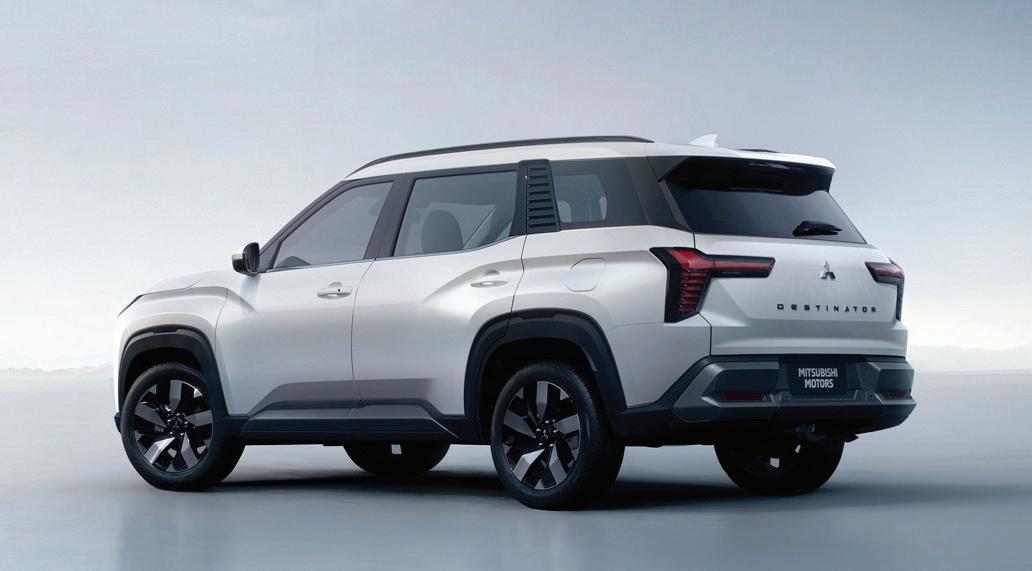
adds character to the vehicle’s side profile, giving it a unique touch that sets it apart from more conventional-looking crossovers. At the rear, a wide LED light bar stretches across the tailgate, with the Destinator name proudly displayed—an unapologetic declaration of identity.
The cabin, while sharing some architectural elements with the Xforce, is far from basic. Mitsubishi has upgraded the interior materials to include soft-touch leatherette panels, ditching the fabric dash of its sibling in favor of a more upmarket feel. The large 12.3inch infotainment display dominates the center stack and is complemented by an 8-inch digital instrument cluster. Audio is powered by a Yamaha Dynamic
Sound Premium system, which delivers surprisingly rich sound for a vehicle in this segment.
Adding even more sophistication is the Destinator’s panoramic sunroof, a rarity in its price category, which bathes the interior in natural light and elevates the overall sense of spaciousness. The cabin ambiance is further enhanced by Mitsubishi’s first use of customizable 64-color ambient LED lighting, allowing drivers to personalize their space depending on mood or time of day.
When it comes to safety and driver assistance, the Destinator doesn’t cut corners. It comes equipped with Mitsubishi’s latest suite of advanced driverassistance systems. These

include autonomous emergency braking, blind spot monitoring, rear cross-traffic alert, full-speed adaptive cruise control, and lane departure warnings—all working together to offer a safer, more relaxed drive whether in heavy traffic or on the open road. Set to make its global debut at the Gaikindo Indonesia International Auto Show on July 24, the Destinator will be positioned as a stylish and techloaded alternative in the compact SUV category. Its primary markets are expected to be the ASEAN region, with the Philippines very much at the center of that strategy. Pricing has yet to be confirmed, but it will likely sit slightly above the Xforce—making it an attractive option for buyers looking to level up from smaller subcompacts or sedans.

For Mitsubishi, the Destinator represents more than just a new model—it’s a reflection of their growing commitment to Filipino drivers and the Southeast Asian market at large. With a turbocharged engine, premium finishes, and regional-specific tuning, the 2026 Mitsubishi Destinator looks well-prepared to live up to its name: a crossover built to take you where you’re headed—confidently and in style.
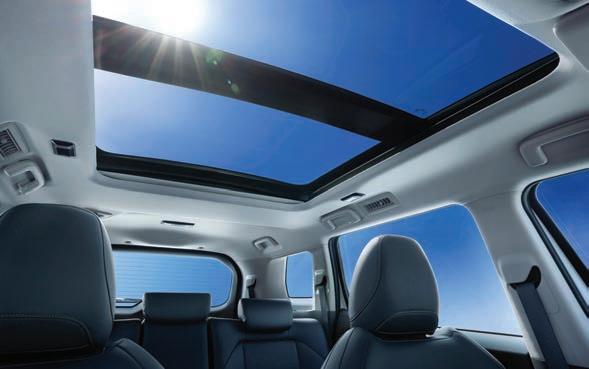

ROLLING STORES, KITCHENS, AND DREAMS
Words by Anjo Perez


When Toyota first launched the Next Generation Tamaraw in 2024, it wasn’t just bringing back an icon—it was reviving a platform for productivity. Known as a workhorse in the late ‘70s through the early 2000s, the Tamaraw became synonymous with livelihood. Today, that spirit is reborn as Toyota Motor Philippines (TMP) introduces three ready-to-work Tamaraw variants tailored specifically for small and growing businesses.
Officially unveiled under the campaign “Abante, Posible,” the Tamaraw now comes in Wing Van, Mobile Store, and Food Truck configurations—each one thoughtfully engineered by Toyota as Original Equipment Manufacturer (OEM) builds. That means no more thirdparty body conversions or long wait times. These are factorystandard, Toyota-warranted vehicles that budding entrepreneurs can now order through any dealership across the country.
Let’s break down what makes each variant a powerful business tool on wheels.
The Wing Van: Built for the Backbone of Local Logistics
If you’re in the business of delivery, distribution, or mobile services, the Tamaraw Wing Van is designed to be your most reliable partner. Whether you’re hauling dry goods, groceries, laundry equipment, or farming supplies, this variant offers a durable and secure cargo solution. The body is made of fiberglassreinforced plastic for long-term toughness, while its triplewing side doors provide wide, easy access when loading or unloading. It’s especially convenient for navigating tight urban streets or rural supply routes where space is limited.
Security is also addressed with lockable side compartments that keep your cargo protected while in transit or parked. Because it’s built on the longwheelbase Tamaraw chassis and powered by a 2.4-liter diesel engine mated to a manual transmission, it has
more than enough torque to manage full loads, even on hilly provincial roads. For logistics startups, mobile cleaning services, or agricultural distributors, the Wing Van is not just a delivery vehicle—it’s a rolling extension of your business.
The Mobile Store: Retail on the Move
The Tamaraw Mobile Store is Toyota’s answer to the rising demand for portable, flexible, and low-cost retail. It serves as a fully functional, mobile storefront—perfect for enterprising Filipinos who want to operate without the burden of expensive commercial rent. With aluminum composite paneling, a fold-down side window supported by struts, built-in lighting, and secure interior cabinetry, the Mobile Store allows sellers to hit the streets ready to do business.
Whether you’re offering ready-to-wear clothing, tech accessories, school supplies, or pasalubong items, this variant gives you a visually engaging and functional display area
that can be set up within minutes. It even comes with jackstands to stabilize the unit during vending operations. If your business thrives in pop-up markets, barangay centers, campus corners, or parking lots near transport terminals, the Mobile Store brings your products directly to your customers with ease and style.
The Food Truck: Cook, Create, and Serve
The Tamaraw Food Truck is perhaps the most exciting variant in the lineup—Toyota’s
answer to the growing food truck culture in the Philippines. Designed as a full-service mobile kitchen, this variant is ideal for chefs, home-based food brands, or small catering services ready to go on the road. Its interiors are fitted with food-grade materials, while a freshwater tank with pump, a separate wastewater tank, interior lighting, and a built-in serving window are all part of the standard setup.
A rear-mounted service counter makes customer interaction
seamless, while the builtin industrial-grade plug and circuit breaker system allows you to run essential kitchen equipment safely—whether it’s a coffee machine, deep fryer, or food warmer. Rear jackstands ensure stability while parked, giving owners confidence when operating in uneven terrain. For entrepreneurs entering the mobile café scene, food parks, weekend markets, or private events, the Food Truck variant offers a plug-and-play setup that brings culinary ideas to life, wherever opportunity strikes.
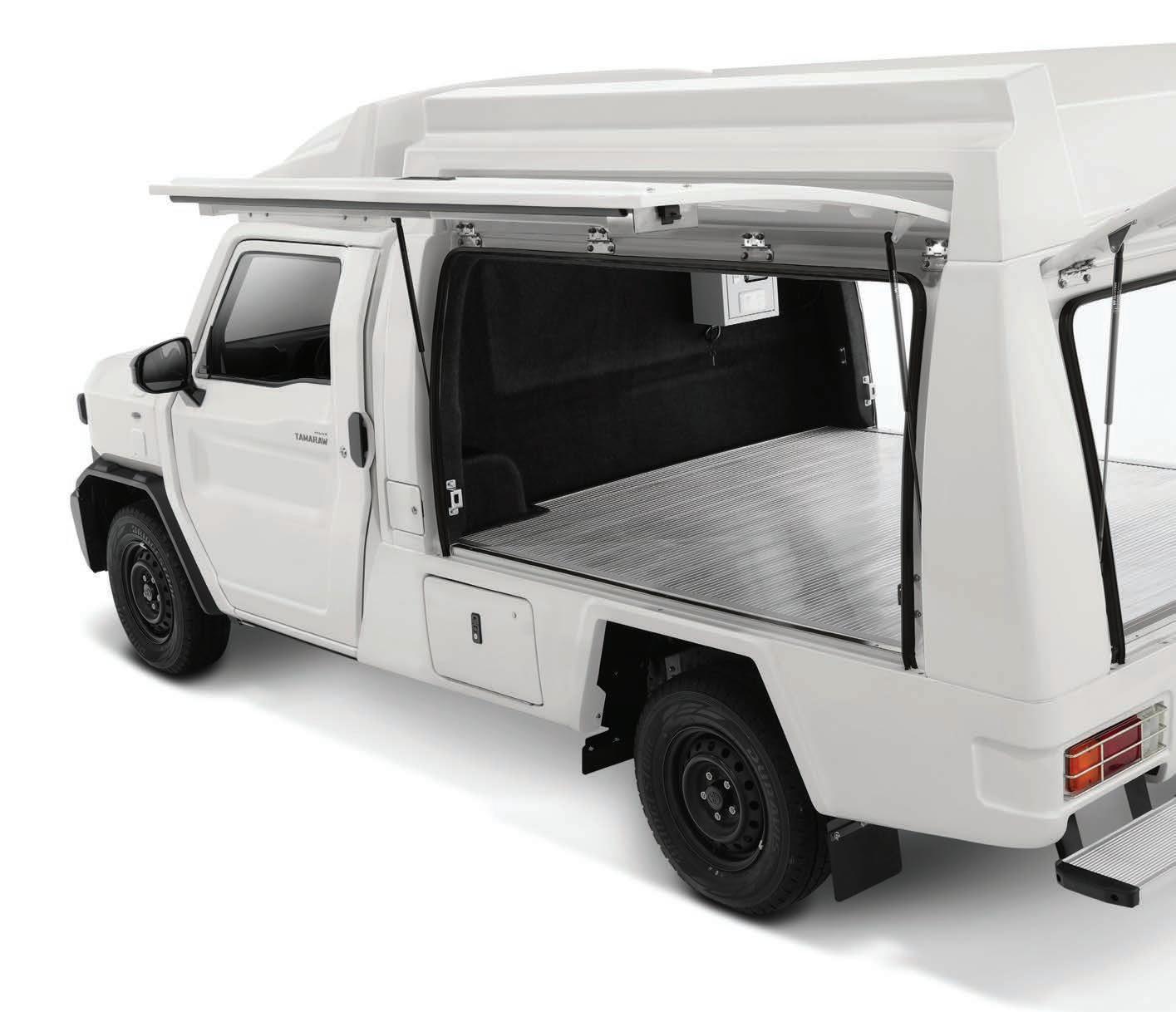
“For sari-sari vendors expanding into new territories, for mobile baristas launching their first café, or for retailers reaching customers outside the metro, Toyota’s new Tamaraw variants deliver more than convenience—they deliver real opportunity.”
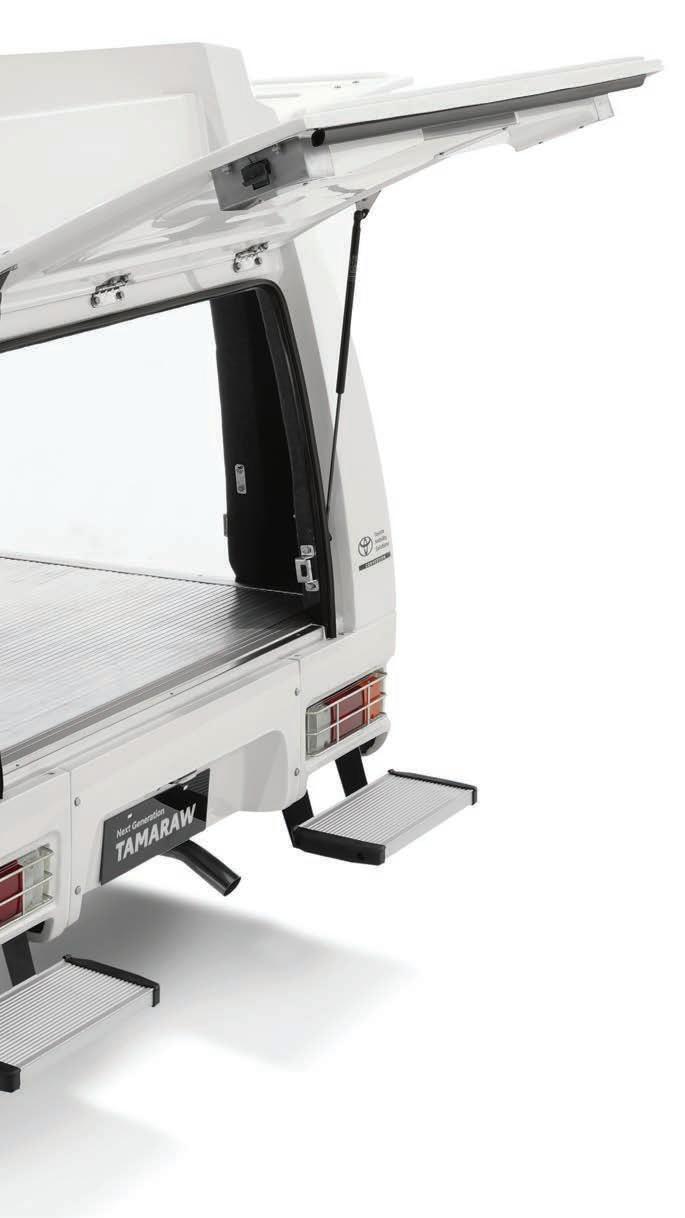
All Business, All Toyota What truly sets these Tamaraw variants apart is their practicality and the peace of mind that comes with owning a Toyota. All three are built on the robust 2.4-liter diesel-powered long-wheelbase chassis, giving them the strength to handle payloads while remaining fuelefficient. Their electrical systems come pre-wired to support small business operations, and because they are OEMcertified builds, they are eligible for Toyota’s full warranty and aftersales service. No more guesswork. No more sketchy third-party modifications. Just straight-from-the-factory reliability, tested and backed by the same company that built the Hilux and Hiace.
Pricing and Financial Support
The Tamaraw Wing Van starts at ₱1,450,000, while the Mobile Store is priced at ₱1,490,000. The most fully equipped of the three, the Tamaraw Food Truck, is available at ₱1,540,000. To make things even more accessible, Toyota is offering flexible financing plans, inhouse insurance packages, and business loan partnerships, giving MSMEs a smoother path to vehicle ownership and business launch.
With monthly payments tailored for entrepreneurs, and a service network that stretches from Baguio to Bongao, Toyota ensures that running your mobile business is as stress-free as possible.
Driving the Filipino Dream
“These conversions further exhibit the Tamaraw’s flexibility,” said Elijah Marcial, TMP’s First Vice President for Vehicle Sales Operations. “With the increased availability, we hope more Filipino MSMEs can grow their business with the Next Generation Tamaraw—because with the Tamaraw, abante posible.”
Indeed, the Tamaraw is more than just a utility vehicle—it’s a catalyst for empowerment. For sari-sari vendors expanding into new territories, for mobile baristas launching their first café, or for retailers reaching customers outside the metro, Toyota’s new Tamaraw variants deliver more than convenience—they deliver real opportunity.
Your next business move doesn’t have to be on paper. With the Next Generation Tamaraw, it’s already on wheels.

PHOTO CAPTION: Note: Images shown are for illustration purposes only. Final production units may vary slightly in features, specifications, and design
TOYOTA’S RACING TRUCK REVOLUTION TAMARAW UNLEASHED
Words by Anjo Perez
LARK, Pampanga—
Toyota Motor Philippines (TMP) is set to break new ground in the local motorsport scene with the launch of the Tamaraw One-Make Race, which will join the Toyota Gazoo Racing (TGR) Philippines Cup as a separate category starting in the 2026 season. The announcement was made during the season finale of the 11th TGR Philippines Cup at Clark International Speedway, capping off a year that has been marked by innovation, exciting comebacks, and record participation.
-anticipated Tamaraw OneMake Race will feature specially prepared race trucks built by renowned tuning house Autoplus, headed by Carlos Gono and Luis Gono. Two Tamaraw variants were
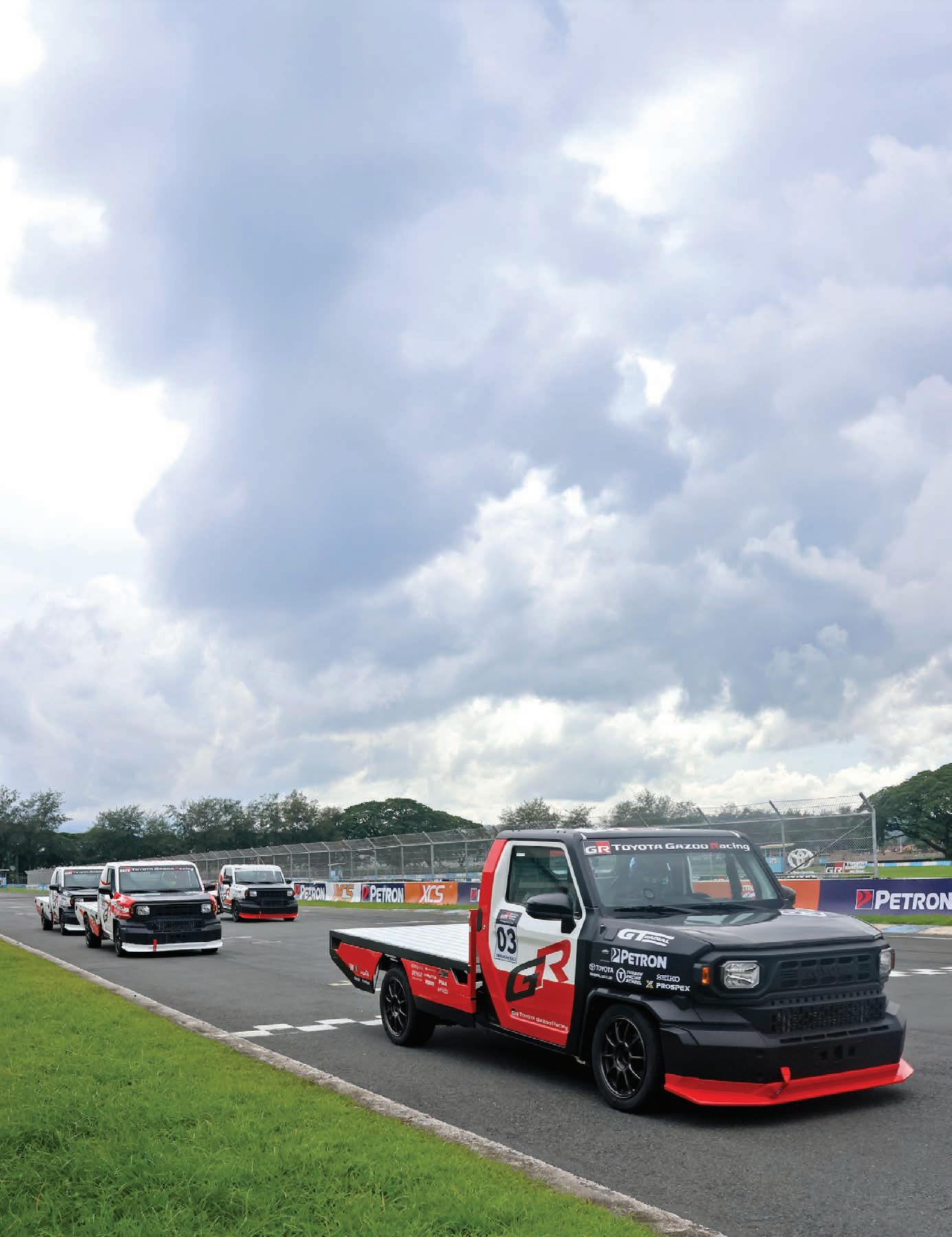
unveiled during the finale—one set up for circuit racing and another for drag racing—both demonstrating the platform’s versatility and potential for multiple motorsport disciplines. Fans were treated to a sprint exhibition race that saw past Vios Cup champions take the wheel, offering a preview of what’s in store for next year’s official grid.
The circuit racing Tamaraw underwent a complete transformation for track duty. Safety upgrades included a fully stripped interior, a customfabricated and welded roll cage, four-point racing harnesses, a racing seat, a power kill switch, a competition-grade steering wheel, a safety net, a fire extinguisher, and front and rear tow hooks. Performance enhancements came in the
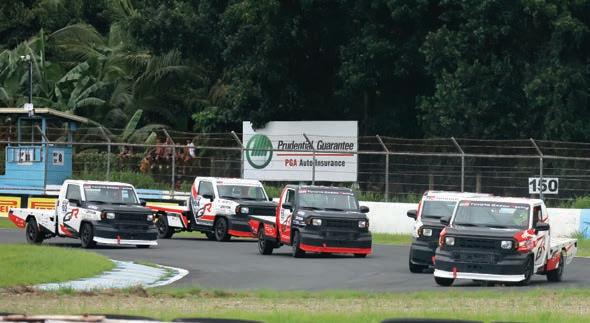
form of a larger intercooler and piping, a racing exhaust system, and Ravenol RCS Racing Oil. The drivetrain was strengthened with a racing clutch, a limited-slip rear differential, and Ravenol VSG transmission oil, while handling was sharpened through the installation of TRD Tein
suspension, racing brake pads with steel braided hoses, Ravenol Racing 325 brake fluid, corner weighting, suspension tuning, and a precise race alignment.
For the drag racing Tamaraw, Autoplus went even further, creating a 320-whp setup that included a custom compound
“We are working to make these Tamaraw race trucks available as complete race-ready packages by next year. We want to lower the barrier for entry into motorsports while keeping it competitive and thrilling.”
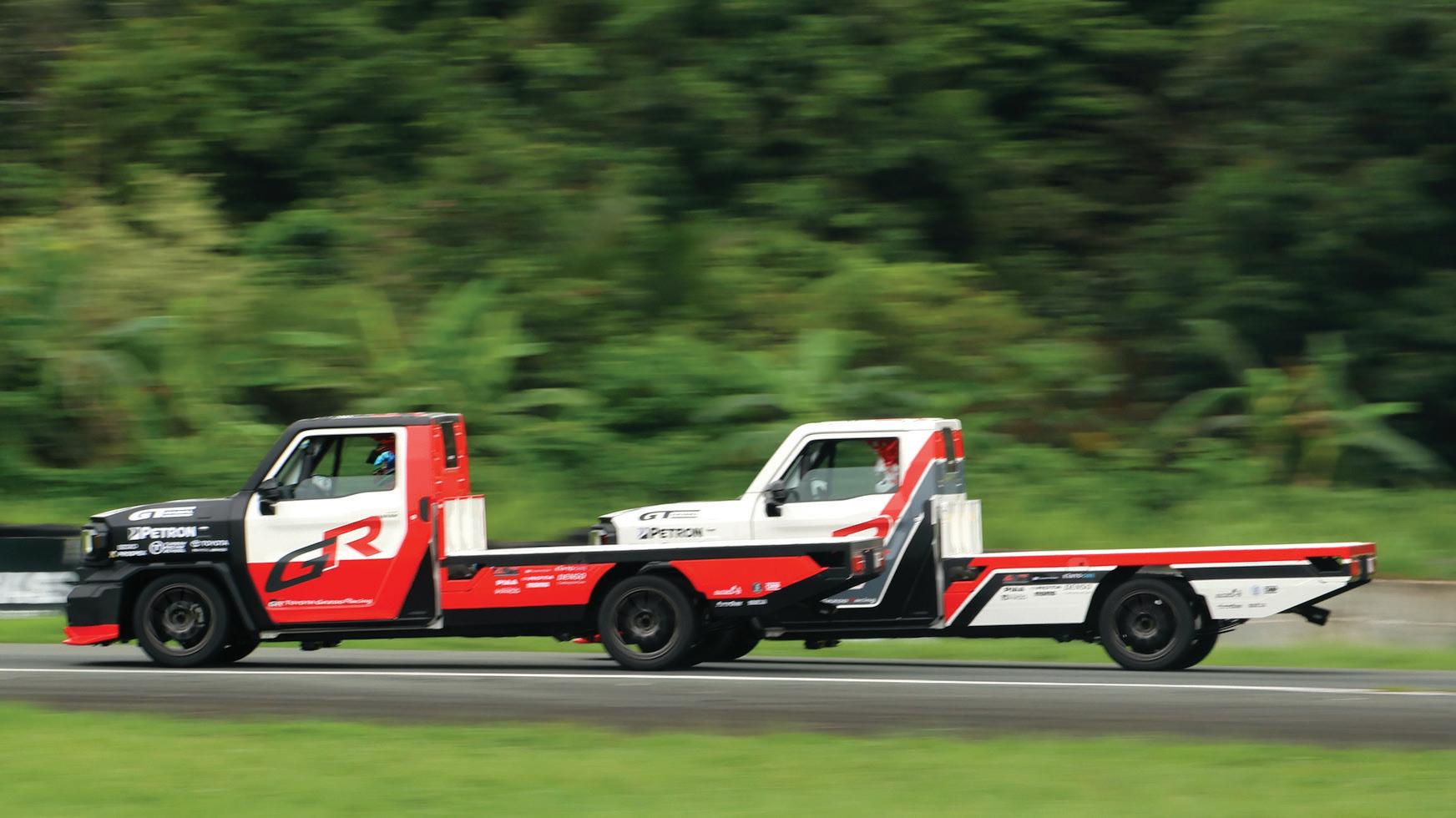
twin-turbo system with upgraded intercooler and piping, a custom three-inch open exhaust, and aerodynamic modifications such as a bespoke rear wing and front lip. This high-powered build was designed to showcase the Tamaraw’s performance capabilities beyond the circuit, with TMP hinting at possible participation in local drag racing events in the future.
TMP President Masando Hashimoto described the new racing category as a bold step forward. “The Tamaraw has always been a symbol of durability and versatility for Filipinos. Bringing it to the race track is something fresh, exciting, and uniquely ours. We want to show that motorsports can go beyond the usual—this is about creating new experiences
for our racers and fans,” he said. Hashimoto also revealed plans to make the Tamaraw race trucks available as complete, race-ready packages by next season, saying, “We are working to make these Tamaraw race trucks available as complete race-ready packages by next year. We want to lower the barrier for entry into motorsports while keeping it competitive and thrilling.”
According to TMP AVP for Marketing Services Andy Ty, the Tamaraw One-Make Race will be a full-fledged category with its own grid, running alongside the established Vios Cup classes.
“It’s about expanding our racing program and giving more people the chance to experience the Gazoo Racing spirit. The Tamaraw is a new platform that can
also inspire other motorsport disciplines like drag racing,” Ty explained. TMP is targeting at least 30 Tamaraw race trucks on the grid for its debut season. The announcement capped off what has been a standout year for the TGR Vios Cup. One of the season’s biggest highlights came in May, when the series returned to street circuit racing for the first time in seven years with a round held at Villar City in Las Piñas. The event transformed the township’s roads into a temporary racetrack, drawing in large crowds who lined the barriers to witness wheelto-wheel battles up close. It was a rare spectacle for local motorsport fans, combining the raw energy of street racing with the professional execution of a manufacturer-backed event.
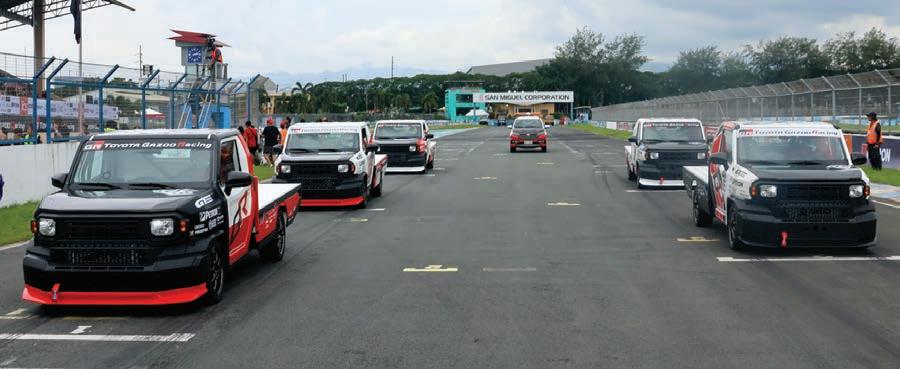
The success of the Villar City race demonstrated that street circuits still hold a special place in Philippine motorsport culture, paving the way for similar events in the future.
This year also saw the introduction of the Legacy Class for older Vios Cup race cars, allowing long-time competitors to bring their machines back into action. The combination of new categories, the return of the street race, and a recordbreaking grid of more than 70 cars made the 2025 season one of the most dynamic in the event’s history.
Hashimoto concluded by emphasizing the company’s long-term vision for Philippine motorsports. “This is not just about racing trucks—it’s about pushing boundaries, developing local motorsport talent, and giving fans something they have never seen before. The Tamaraw One-Make Race will be uniquely Filipino, and we can’t wait to see the grid full next year.”
TMP is once again proving that its Gazoo Racing program is not afraid to innovate. From the streets of Villar City to the high-speed straights of Clark, the stage is set for a new chapter in the country’s motorsport story— one that will soon see the iconic Tamaraw trading its workhorse image for a place on the starting grid.
FROM MANILA TO THE COLOSSEUM
FILIPINO VESPISTI JOIN THE RIDE OF A LIFETIME
ROME GEARS UP FOR VESPA’S 80TH BIRTHDAY BASH—AND THE PHILIPPINES IS PROUDLY ON THE GUEST LIST
Words by Anjo Perez
There are birthday parties—and then there are iconic, history-making celebrations. In June 2026, Vespa, the world’s most beloved scooter brand, will mark its 80th anniversary with what’s expected to be the biggest global gathering of Vespisti ever. The city of Rome will be the stage, the scooter will be the star, and the streets will be filled with the familiar purr of two-stroke engines and the hum of modern electric Vespas weaving through cobblestone alleys and historic landmarks.
Amid the sea of riders from every corner of the world, a proud delegation of Filipino Vespa enthusiasts will be flying in, ready to make their mark on this grand occasion. The Vespa Club of the Philippines (VCOP) has confirmed its participation and is already deep in preparations to represent the country at this once-in-alifetime event.
Rolling Tradition, Rekindled
The Vespa Club of the Philippines was originally founded in 1957, but like many beautiful things in life, it took some time to regain traction. Officially re-registered and reestablished in 2006, VCOP has since blossomed into one of the most passionate and active Vespa communities in Southeast Asia. Today, its members span generations and provinces, connected not just by the scooters they ride but by a deep love for the lifestyle, freedom, and camaraderie that Vespa inspires.
“We currently have hundreds of active members who participate in regular
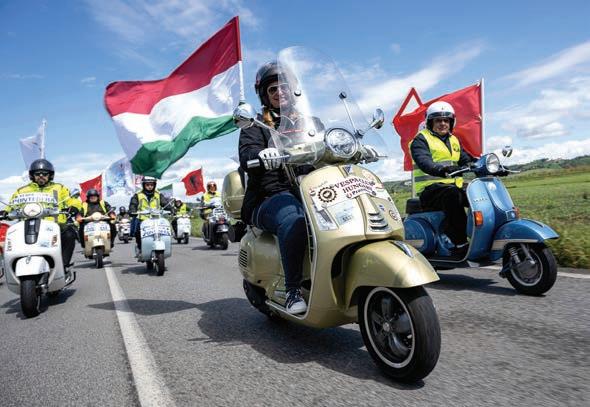
rides, charity events, and collaborative gatherings with local and international Vespa clubs,” shares Joseph Papa, VCOP’s National Federation Public Relations Officer. “For Rome 2026, we are preparing a delegation of around 30 riders. Travel, logistics, and support coordination are all in motion.”
On the Road to Rome
From June 25 to 28, 2026, Rome will transform into a living museum, concert stage, and scooter-filled utopia. Vespa’s anniversary celebration promises more than just a parade—it’s set to include art exhibits, music festivals, film screenings, and immersive cultural experiences that showcase the scooter’s impact on society, style, and personal expression. With its roots in post-war Italy and a design that has stood the test of time, Vespa isn’t just a mode of transport—it’s a global icon.
For the Filipino delegation, joining this milestone event is more than a bucket-list item. It’s a chance to connect with
the global Vespa brotherhood, share stories from the Philippine riding scene, and fly the flag for the thousands of enthusiasts back home.
Celebrating at Home and Abroad
Back on local soil, VCOP isn’t just waiting around for Rome. In August 2025, it will host Pilipinas Vespa Days in Iloilo, an event expected to draw hundreds of riders from across the country and beyond. Much like Rome, the Iloilo gathering will be a celebration of culture, connection, and the enduring charm of the Vespa. It’s part of a broader plan to engage Filipino riders leading up to the global celebration.
“In celebration of Vespa’s 80th anniversary, we’re also preparing several special projects and commemorative memorabilia,” Papa reveals. “These include limited-edition merchandise, collaborative art pieces, and localized events that spotlight Vespa’s cultural influence in the Philippines. We’re even exploring ways to


link these celebrations to other international Vespa milestones.”
Whether it’s a lovingly restored PX150 from the ‘80s or a brand-new GTS, every Vespa tells a story. And come 2026, a new chapter will be written—one that begins in the Philippines and leads to the heart of Italy.
More Than a Scooter
For those who ride them, Vespas aren’t just machines. They’re companions. They’re a statement. They’re a lifestyle. And as the brand enters its eighth decade, it carries with it a legacy not only of design excellence but of bringing people together—across languages, countries, and cultures.
Rome 2026 won’t just be a celebration of Vespa. It will be a celebration of everyone who has ever taken the long way home, turned a commute into a joyride, or made friends through a shared love of two wheels. The Filipino Vespisti are ready to take their place in that story— and they’re bringing the whole community along for the ride.
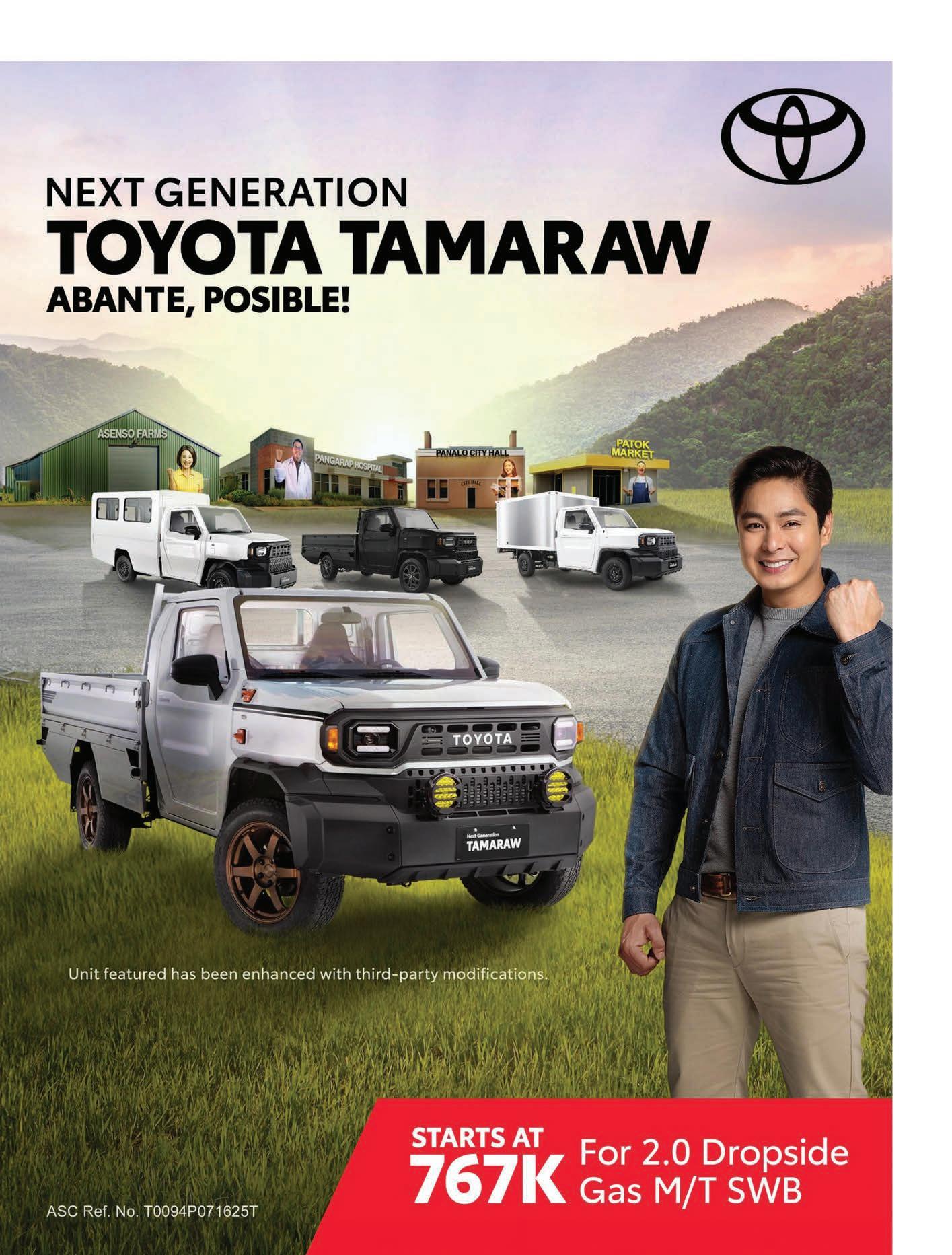
A MAGAZINE ON BIKES, VANS, TRUCKS AND SUVS
FROM MANILA TO THE COLOSSEUM: FILIPINO VESPISTI JOIN THE RIDE OF A LIFETIME




ROLLING STORES, KITCHENS, AND DREAMS
THE TAMARAW RETURNS FOR THE NEW GEN
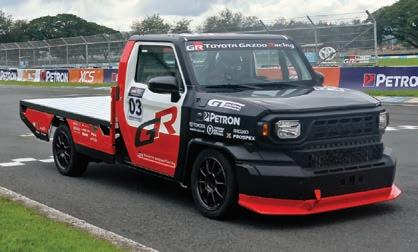

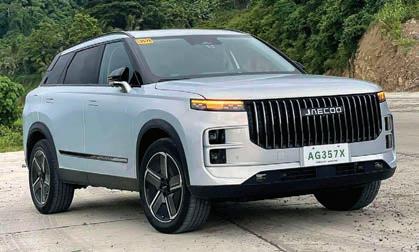
TAMARAW UNLEASHED MITSUBISHI DESTINATOR JAECOO J7 SHS
